June 25, 2007
United Nations Plaza
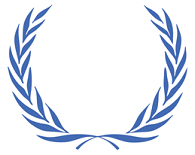
Inaugurates WUNP – 95.2 FM
The United Nations Plaza Radio Network, WUNP – 95.2 FM :: Inaugural Broadcast – LIVE INTERNET STREAM :: June 30, 9-11pm CEST (Berlin) :: unitednationsplaza, Platz der Vereinten Nationen 14a, Berlin 10249, Germany :: followed by a party at Salon Aleman.
WUNP is a radio station produced by neuroTransmitter [Valerie Tevere + Angel Nevarez] for United Nations Plaza. WUNP is a portal for broadcasting audio works and conceptual radio projects. Over the course of the summer and fall of 2007 WUNP will be on air across Berlin (95.2 FM) and beyond through internet stream. We will initiate our broadcast schedule with special in-studio contributions and conversations with: Fia Backström, Regine Basha and Julieta Aranda, Uta Meta Bauer and Piotr Nathan, Karl Holmqvist, Stefan Saffer, and Tirdad Zolghadr.
WUNP radio programs will be available for continuing use in cassette form and are accompanied by a script or blurb to radio broadcasters.
Local broadcast times: 9-11am Honolulu / 11am-1pm Anchorage / 12-2pm Los Angeles, Vancouver / 1-3pm San Salvador / 2-4pm Bogotá, Mexico City / 3-5pm Montréal, New York / 4-6pm Buenos Aires, São Paulo / 4:30-6:30pm St. John’s / 7-9pm Casablanca, Reykjavik / 8-10pm Algiers, Dublin, London / 9-11pm Berlin, Rome, Zagreb / 10pm-12am Beirut, Istanbul, Nairobi, Ramallah / 11pm-1am Baghdad / 11:30pm-1:30am Tehran / +1 day -- 12-2am Islamabad, Moscow / 1-3am Dhaka / 1:30-3:30am Mumbai, New Delhi / 2-4am Chiang Mai, Hanoi / 3-5am Beijing / 4-6am Seoul, Taipei, Tokyo / 5-7am Sydney / 6-8am Vladivostok / 7-9am Auckland / 8-10am Anadyr / 9-11am Christmas Island /
United Nations Plaza is organized by Anton Vidokle in collaboration with Liam Gillick, Boris Groys, Martha Rosler, Walid Raad, Jalal Toufic, Nikolaus Hirsch, Natascha Sadr Haghighian and Tirdad Zolghadr.
For further information, please contact:
Ms. Magdalena Magiera
unitednationsplaza
Platz der Vereinten Nationen 14a
Berlin 10249 GermanyUNP
T. +49 (0)30 700 89 0 90
F. +49 (0)30 700 89 0 85
Posted by jo at 08:53 AM | Comments (0)
April 06, 2007
Upgrade! Brussels/Ghent

On Public Space and Sound Practices
Upgrade! Brussels/Ghent: On Public Space and Sound Practices :: We examine and discuss meshed networks in public space. Artist networks reappropriate public space by means of sound, and comment and annotate public space by soundtags. Can we speak of hybrid transmission spaces? Do these mobile modes of exchange provoke new creative practices? Project presentations by Tapio Mäkelä; Justin Bennett; Sarah Washington and Knut Aufermann. Discussion moderated by Annemie Maes and IRC chat by Dusan Barok.
Tapio Mäkelä: My first radio project was called Sound Calendar in 1994 with artist association MUU. Sound Calendar consisted of 24 sound pieces by participating artists, broadcast before morning and evening news on Finnish national radio and through intercoms at eight Finnish railway stations. My own piece in the work made me an accidental radio hacker as it caused a shut down of the entire Finnish radio network for approximately 10 minutes. My interest in hybrid uses of radio has to do with combining Internet radio with listening or participatory interfaces in public spaces.
I am currently developing “Translocal radio workshops” in two locations in the Barents Sea region. Inter-connected artist led workshops in Kirkenes (No) and Murmansk (Ru) bring together media and sound artists and community groups to develop content locally and across the border. The work is presented through public events and temporary listening environments as well as through Internet radio and temporary FM. The workshops are planned for late summer this year and Spring 2008.
In the summer of 2008 a fourth Polar Circuit workshop will take place in the Baltic Sea. Concept:Islands, among other topics, invites participants to experiment with radio and mesh-up networks and alternative energy solutions. In both of these workshops I am working on a sound archive with geo-annotation, not with an interest of GPS as such, but how the location of samples and interviews can also be a meaningful archival interface.
Justin Bennett is an artist and composer working with sound and visual media. While living in Sheffield in the 1980's he colllaborated with bands such as Hula, TAGC, and Fabricata Illuminata. Since 1989 he is based in the Netherlands. Bennett is best known for his work with field recordings, which he uses to create installations, soundwalks, CD-releases and live performances. Much of his work is concerned with urban space and the relationship of sound to place. In the last few years he worked with GEM Den Haag, the CCS, Paris, the Guangzhou Triennial, moorroom Roma, Sonic Arts Network, UK. Upcoming projects include a permanent sound work for a public space in The Hague and a text-based piece for a park in Luxembourg. He collaborates with, among others, BMB con., Renate Zentschnig, Grand Mal, 242.pilots, Kreutzerkompani.
Sarah Washington and Knut Aufermann talk about the radio lives and works that have been encountered by in their last one and a half years on the road around Europe. Working in more than a dozen countries and meeting people from all over Europe, visiting their projects, doing workshops and participating in radio conferences, festivals and live-to-air events, has give these 'radio gypsies' a unique overview of the state of experimental radio activity across Europe today. In this presentation they will also give you a taste of their own approach to radio production, and demonstrate how their ongoing enthusiasm for the medium allows them to develop singular radio events in cooperation with others.
Posted by jo at 11:39 AM | Comments (0)
March 09, 2007
X-Com: An Auditive Mapping-Project
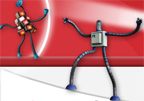
Soundscapes as Cultural Artifacts
X-Com: An Auditive Mapping-Project by MACHFELD (aka Sabine Maier & Michael Mastrototaro) :: In cooperation with: Cityvarsity and Trinity Session, Johannesburg, South Africa.
In times of global networking MACHFELD (Sabine Maier & Michael Mastrototaro) and the Trinity Session (Marcus Neustetter & Stephen Hobbs) use digital and analog devices to create an auditive communication-soundscape. This soundscape will be transformed to a crosscontinental sub-room in form of an art-radio broadcast. Supported by students of the Cityvarsity we will analyse the phenomen of inter- and transcontinental communication and we will find an answer for the question: How are soundscapes related to cultural facts?
This audio mapping will be the starting point of a Ö1 Kunstradio Broadcast which will air in autumn 2007.
MACHFELD, international Arts and Culture Society, Max Winter - Platz 21/1, A-1020 Vienna.
Posted by jo at 08:19 AM | Comments (0)
Resonance FM programme is number one podcast on iTunes
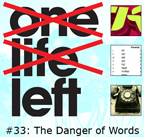
One Life Left
Number-one-rated gaming podcast Resonance Fm's One Life Left wins Europe's only gaming radio show, broke its own download records for the fourth consecutive week Wednesday and ended the day in the prestigious #1 slot on iTunes for the first time in history. Beating out commercially-produced internet broadcasting from 1UP, PC Gamer, Official Xbox Magazine, EGM and Xbox Live's Major Nelson, the One Life Left podcast - available for free here - has won critical acclaim by industry commentators worldwide for its brave use of soundwaves to communicate the thrill of videogaming.
The number-one-rated show's success is unprecedented for a traditionally-broadcast gaming radio programme; not exactly surprising, since there are only two traditionally-broadcast gaming radio programmes on the planet. But it also marks a victory for non-commercial broadcasting in general and British broadcasting specifically. The iTunes top twenty is dominated by American magazine, website and mega-corporation-sponsored podcasts. One Life Left is supported and broadcast by Resonance FM, an arts-council funded station in London, UK, and remains wholly independent.
One Life Left's content is original and unique to the show, produced completely from scratch by a host of famous and not-quite-famous-yet contributors. The record-breaking Show #33, subtitled 'The Danger of Words', features many of those regulars and includes reviews, gaming gambling and fast-paced gaming poetry, as well as two bona-fide industry legends in audio disguise.
About One Life Left: Commissioned by London's award-winning Resonance 104.4 FM in early 2006, One Life Left began its second season in January 2007 in a new prime-time evening slot, and has grown from humbling, terrified, fumbling beginnings to become one of the station's most valued shows. One Life Left broadcasts every Monday from 08:00 - 09:00pm on Resonance 104.4FM and streams at www.resonancefm.com.
Ste Curran, Robert Howells and Ann Scantlebury present One Life Left which without fail is always a sweet blend of light-hearted discussion, music, interviews and ridiculous features, One Life Left is unique in gaming and in radio. Guests and contributors include industry legends past and present, many of whom continue to contribute regular features to the show under assumed names. OLL has broadcast from the Develop Conference and Edinburgh Festival, as well as covering a variety of events national and international, and have many exciting secret plans for 2007.
Posted by jo at 07:57 AM | Comments (0)
March 07, 2007
‘If the route’: The Great Learning of London

[A Taxi Opera]
‘If the route’: The Great Learning of London [A Taxi Opera] :: PerformanceStudio Voltaire :: Friday 9th March at 7.30pm :: The radio works: 104.4 Resonance Fm, Wednesdays 9pm 14th of March - 25th April 2007. More times below.
A collaboration between artist Beatrice Gibson and musician Jamie McCarthy, ‘If the Route:’ The Great Learning of London is a live performance and radio work in seven parts based on The Knowledge (the infamous London cabbie navigation system and mnemonic device students must master in order to become licensed cabbies). The Performance: The live performance of the 'if the route' has been developed collaboratively with 10 students from Knowledge Point and four improvising string players. A complex and fascinating mathematics of the everyday, The Knowledge involves learning 320 routes or runs mapped within a six-mile radius of Charing Cross. Traveling approximately 26,000 miles across the city on Honda C90's, knowledge students memorize a total of 30,000 streets. ‘Calling over’ entails that after the completion of the days run[s], students must call them out, reciting them out loud. Partners form to call over runs to one another, using recital and repetition as a means to remember the city.
Knowledge Point on Caledonian road, one of several taxi universities students may attend and whose curriculum includes a series of mnemonic devices to aid in their endeavor, is filled with pairs of men and increasingly the odd woman aurally reciting sets of directions to one another. Entering it is to be surrounded by the city fragmented and auralized into sets of sentences and street names, a veritable symphony performing the city as text .
Using the technique of calling over as its principle sound source, the performance of ‘if the route’ celebrates and elaborates this formidable system and poetic by re-contextualizing it within in the space of the gallery. Modeled on paragraph seven of Cardew's original score, Gibson and McCarthy's compositional structure emphasizes the practice of calling over as an ongoing process of repetition, memorization, rehearsal and navigation, articulated in a networked and non heirarchical manner.
The Score
‘If the Route’ takes it title from The Great Learning, the well known score by the radical and experimental 60’s composer and musician Cornelius Cardew. Informed by similar developments and ideals in the Fluxus movement and realized around the same period, Cardew’s work was rooted in belief of the democratic potential of music as a social platform, his score’s often intended for implementation by untrained musician-performers. Cardew’s version of the Great Learning was a score in seven paragraphs, rooted in and acoustically generated by the Confucian text of the same name. Playing on the title of ‘the great learning’ as it relates to The Knowledge and its own system of learning, and borrowing from the methodology, structure and political intent of Cardew’s score, Gibson and McCarthy have used both aural and non aural research into the knowledge as the generative principle behind composition. The score for 'if the route' provides the basis for both realization of live perfo rmance and the radio works.
The Radio Works
Mirroring the seven paragraphs of Cardew’s score, the radio piece comprises seven parts and takes place over seven weeks. In keeping with the spirit of Cardew and the political gesture of experimental composition in general, seven practitioners from varying fields and disciplines have been commissioned by Gibson and McCarthy to use and translate the score for radio according to their own personal and varying interpretations.
Participants include; artist and architect Celine Condorelli, artist Beatrice Gibson, musician and composer Kaffe Matthews, musician Jamie McCarthy, artist and writer, Tom McCarthy, poet and cabbie, Simon Phillips, and architect and theorist, Eyal Weizman in collaboration with Peter Mörtenböck & Helge Mooshammer (Networked Cultures)
Wednesday 14th March 9pm Beatrice Gibson and Jamie McCarthy
Wednesday 21st March 9pm Celine Condorelli
Wednesday 28th March 9pm Simon Phillips
Wednesday 04th April 9pm Eyal Weizman in collaboration with Peter Mörtenböck & Helge Mooshammer (Networked Cultures)
Wednesday 11th April 9pm Tom McCarthy (International Necronautical Society)
Wednesday 18th April 9pm Kaffe Matthews
Wednesday 25th April 9pm Beatrice Gibson and Jamie McCarthy
'If the Route:' The Great Learning of London is generously supported by Arts Council England. Partnered by Studio Voltaire and Resonance FM.
With special thanks to London Contemporary Dance School at The Place.
Posted by jo at 11:43 AM | Comments (0)
February 27, 2007
foodradio_network presents

"live_feed: Snack City" CALL IN
foodradio_network presents live_feed : Snack City from the MediaWala Festival as the culmination of a two day workshop with local / international / remote participants exploring the culture and politics of streetfood. CALL the SNACK CITY OPEN PHONE IN and talk to us about your favorite street food. Share the taste, smell and the sound of your favorite neighbourhood street snack joint live.
Turn your phone into a microphone! 1. CALL 9818977450 (DELHI) 2. Listen to the phone ring twice and go quiet 3. You are ON AIR! LISTEN LIVE :: 8pm-10pm IST - Thu, March 1st free103point9 Online Radio
foodradio_network is an open and variable network of broadcasters and foodsters exploring the culture, politics and creativity of food as a medium and a metaphor for experiments in participatory and collaborative live radio. They regularly dish up aural appetisers on their show live_feed which plays on free103point9 online radio. live_feed @ MediaWalaFestival includes participants from Australia, India, Finland, America... and possibly also You!
Posted by jo at 08:36 AM | Comments (0)
January 30, 2007
The Burning Question
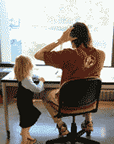
Gallery as Radio Station
The Burning Question, by Abinadi Meza, is a participatory installation and internet radio broadcast. This project consists of customized computers, large color posters, and pamphlets examining Intellectual Property and copyright. Multiple computers are loaded with hundreds of works contributed by composers, musicians, and sound artists from around the world. Visitors are offered blank CD's and invited to freely burn copyleft music; as they make playlists, they collectively generate an Internet radio broadcast that streams 24 hours a day from the gallery for the duration of the exhibit. The gallery becomes an impromptu radio station and visitors become DJ's. [via Rhizome]
Posted by jo at 02:39 PM | Comments (0)
January 28, 2007
XIV RADIO CREATION WORKS CONTEST
![]()
Contest of Ideas
XIV RADIO CREATION WORKS CONTEST | CDMC-RADIO CLÁSICA 2007 :: The CDMC and Radio Clásica (RNE) are undertaking a collaboration to encourage the production of radio creations in order to promote this type of works. Within this line, a contest of ideas is called subject to the following RULES:
1 The works will necessarily be pieces of radiophonic creation, that is to say, whose most suitable means of production and diffusion is the radio. The works will not have been previously awarded nor emitted. 2 Words, noises, music, electronic or radiophonic editings and other similar elements may be the base of the work. 3 The project may be in Spanish only or in several languages but in this case Spanish should be the main language. The use of language or voice may also be omitted. 4 To enter the contest it will not be possible to send accomplished works, but mere projects: a written description of the work and of the elements that it will require, some excerpts as a model in cassette, CD or DAT, scores or fragments of these, acoustical materials, etc. Any form or presentation will be admitted, provided that it makes possible to the Jury to appreciate the interest of the projected idea.
5 There is no age nor citizenship limit.
6 The deliveries should be made on before April 15th, 2007 by any of the procedures allowed by the Administrative Procedure Act; such as registered mail, (postmark date will probe meeting the deadline), personal delivery, etc; and they should be addressed to:
"XIV Concurso de Obras de Creación Radiofónica"
Centro para la Difusión de la Música Contemporánea
c/ Santa Isabel 52, 5ª planta
28012 -Madrid (Spain)
7 There is no limit to the number of projects to be sent by each author.
8 The projects should arrive anonymously with an assumed name that will be reproduced on an enclosed closed envelope containing a photocopy of the DNI or passport and personal details of the author or authors. In the case of using texts by another author, his opportune permit must be accredited.
9 A Jury appointed by the CDMC and Radio Clásica will choose on the project considered the most suitable. The decisions of the Jury are without appeal.
10 The selected project will be the object of a commission by the CDMC, endowed with 6.000 euros gross. This Commission will be considered as the Prize of the Contest and it is independent of the production costs, which will be assumed by Radio Clásica.
11 Radio Clásica will produce the work with the means that the radio itself will determine. For that purpose, in addition to the human and technical means of the Radio, the facilities of the Laboratorio de Informática y Electrónica Musical del CDMC (LIEM-CDMC) can also be used. The radio broadcasting will take place during the last quarter of 2007, and we will try to give the work première at the Festival de Música de Alicante (end of September 2007). The project should be developed with enough time so that it may be produced and emitted on time.
12 By the simple act of participating, the competitors accept the terms of these Rules and the decision of the Jury.
13 The non-awarded projects will be available to their authors who can fetch them personally at the CDMC, previous identification of the assumed name, within the period of three months after the awarding is made public.
14 Once this period is over, the non-collected projects will be destroyed in order to preserve the anonymity of the Contest.
Contact: jose iges [joseiges[at]wanadoo.es]
Posted by jo at 07:15 PM | Comments (0)
January 17, 2007
Art's Birthday
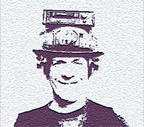
art'n'radio birthday parties
Today is January 17th - Art's Birthday.
It was the French Fluxus artist Robert Filliou who in 1963 proposed a public holiday to praise the presence of this essential cultural activity in our lives. While so far any attempts to install the date in official agendas next to Xmas or Independence Day may have failed, for many people Art's Birthday has definitely become a jour fixe to celebrate with like-minded all over the world.
Yet in 2007 art has to share the date with another cultural achievement: radio.
In case you've never heard about that kind of official jubilee related to the latter or so far associated with another day, don't worry. As many other groundbreaking technical developments radio has more than one inventor. Hence you have the choice which date to celebrate.
But why January 17th, 2007? Even the multi-facetted history of radio provides no direct link to this date. More >> [blogged by miss.gunst on we-make-money-not-art]
Posted by jo at 08:06 AM | Comments (0)
January 03, 2007
SilenceRadio.org
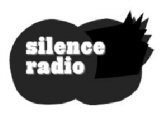
Audio Art Podcasting
What is "silent" about this webpage? And what has it to do with radio? - This website is full of sounds, and what is available there, in best artistic quality, are audiofiles "on demand" or podcasts, not a linear (radio) program. However, the term "radio" in the title is the aesthetic point of reference and directs the attention to the multitude of radiophonic composition principles, which inspired all of the 50 pieces presented here. At the same time it creates the allusion, that the number of radio programs, which distributes prodution like this, is globally declining dramatically. Reknown Audio Artists, like for example Zbigniew Karkowski, Jean-François Augoyard, Chris Watson, Marcus Gammel have given their sound pieces to SilenceRadio.org. Four times per year, the Belgian website-producers make new compositions available.
If you click the website, you will find a number of moving, colourful circles, or - like the website's makers call them - "pastilles". Each pastille is filled with sounds and represents a radiophonic production, which can be listend to "on demand" or as a podcast. The pastilles' colours refers to similar genres and styles: pieces, reportages, which are centred around text and original sounds, exist there beneath mixes, which are close to noise music or soundscape composition. The website understands itself as a listening room for radiophonic productions, and as a kind of sonic "department store", which gives its offers away for free.
However, SilenceRadio.org takes care, that the basic authors' and composers' rights will not be violated, as it makes use of the "creative commons" licence system.
Those, who want to contribute with own productions, can get in touch with the website's producers. For SilenceRadio.org's second birthday there will be open calls going out, encouraging users to create remixes from the already published productions.
More at:
http://www.silenceradio.org/
Podcast / RSS :
http://www.silenceradio.org/rss.php
http://www.acsr.be
http://www.domainepublic.net/
[posted by Sabine Breitsameter on Audiohyperspace]
Posted by jo at 12:19 PM | Comments (0)
December 06, 2006
JOIN KUNSTRADIO'S
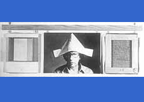
Celebration of Art's Birthday
INVITATION TO JOIN KUNSTRADIO'S CELEBRATION OF ART'S BIRTHDAY 2007! ::Art’s Birthday 2007: Adore and be still ::100 years of radio
Art's Birthday Party is a celebration in memory of Robert Filliou who declared, on January 17 1963, that Art had been born exactly 1,000,000 years ago when someone dropped a dry sponge into a pail of water. After Filliou's death in 1987, some artists began to celebrate Art's Birthday in the spirit of his concept of "The Eternal Network" or "La Fete permanente". The Birthday parties took place in different cities across the world, and artists were asked to bring birthday presents for Art – works that could be shared over the network.
On Christmas 1906, on the other hand, Reginald Aubrey Fessenden undertook the very first radio broadcast of voice and music. Luckily, he had the foresight to time his experiment exactly, its 100th anniversary practically coinciding with the 1,000,044th birthday of Art. We therefore ask you to join Kunstradio's celebration of this stunning fact. We invite you to search your own territories for further firsts in radio history. Premieres of different kinds; the first transmission in stereo, the start of a series of brilliant shows, the first time you listened to the radio, the first time they played 'your' song, the first time you were broadcasting, were on air.
Soundfiles of these broadcasts we ask you to upload to our website.
Feeding on your individual sonic archives and this database of numerous people's special radio moments you can then assemble your own radiophonic versions of our medium's history. These we invite you to stream to our party in Vienna on January 17th, 2007. We will re-mix and further distribute your streams via our live Kunstradio broadcast on the cultural channel of Austrian National Radio Ö1,as well as in our slot on the EBU satellite.
Should you have any questions, please do not hesitate to contact us under kunstradio[at]kunstradio.at
Please feel free to spread the word! This is the party you can bring along as many people as you like!
The short version:
What do we want?
A present. Not for us, for Art's birthday.
Which present?
Your radio's history. Or: Your history of radio.
How?
Streamed, mailed, sent, posted, uploads at
http://kunstradio.at/PROJECTS/AB2007/index.html
Format?
mp3 files, live-streams, images, webcams, ..
When?
January 17th, 2007 from 20:00 - 24:00 CET, 19:00 - 23:00 GMT
Why?
To celebrate.
What?
Art's Birthday.
Posted by jo at 04:34 PM | Comments (0)
November 21, 2006
Live Transmissions
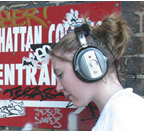
Implications of Paranoia in Sound Art
These days, a radio is a common transmitter of music and information. Historically, radios have had notorious alternative functions as instruments of surveillance. In this article, Anastasiya Osipova discusses how recent sound artists have incorporated the psychology of paranoia into their work, fitting for an environment where surveillance is constant and technology is fervently deployed to detect that which is hidden.
"Newly recruited member of the Resistance walks down the street. Anxiety circulates under his skin. Several uniformed men block his way. “What is inside your suitcase, sir?” “Radio.” They let him pass. He walks into what appears to be a shop, hands the radio transmitter to a portly woman who is standing firm on her high heels, cigarette held to her mouth. At that moment he feels that she, who he is seeing for the first time in life, is closer to him than any family member could possibly be.
Military and entertainment industries share equipment: magnetophones, vocoders, synthesizers, and other tools routinely used by musicians each originally had military functions, to say nothing of the radio, a notorious spy fetish. Leon Theremin, famous inventor of the electronic instrument bearing his name was, tellingly, also a secret agent. Together with technology, radio and sound-related arts have inherited a drive for detection often bordering on paranoia. The suspicion of invisible channels of information into which one is somehow implicated against one’s will—or of networks of communication from which one is excluded—is amplified. Recognizing the psychological power their medium can wield, radio artists are employing its technology in a manner analogous to how the armed forces would: to disclose the invisible and, when appropriate, to mobilize resistance against it." Continue reading Live Transmissions by Anastasiya Osipova, NYFA Current.
Posted by jo at 04:52 PM | Comments (0)
November 10, 2006
OKNO PUBLIC02:
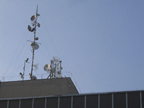
A CONTEMPORARY LOOK AT RADIO ART
OKNO PUBLIC02: A CONTEMPORARY LOOK AT RADIO ART :: 13-18 NOVEMBER 2006 :: OKNO invites you to Public02. In a process of workshops, 2-way radioworks, collaborative and networked sound installations, live broadcasts of radio-art programs, lectures and performances, OKNO offers the broad public a chance to take part in the debate. All events can be attended onsite and online. Check okno's homepage for updated stream-information.
Theoretical and hands-on workshop 'mini FM transmitters' (Tetsuo Kogawa, Jp) :: 13/11 - 1pm: Tetsuo Kogawa covers following topics in an online lecture: - a short history of Mini FM - Mini FM and radio art - the still unknown meaning of micro transmission and why it is relevant today. Following the lecture, Tetsuo Kogawa will give a hands-on introduction on how to build a mini FM transmitter.
Workshop @ okno: monday 13/11 - thursday 16/11 :: Online lecture: monday 13/11, streaming starts at 1pm :: More info: http://www.okno.be/index.php?id=972 :: Stream on http://qt.okno.be:8000/FMtransmitters.sdp or on okno's homepage.
Transversal Transmission -- Tetsuo Kogawa (Jp) and Jacques Foschia (B) :: 15/11 - 7.30pm: A streaming and networked feedback performance between Jacques Foschia (onsite in Brussels) and Tetsuo Kogawa (remote in Tokyo), an hommage to the micropolitics of Felix Guattari.
wednesday 15/11 - 7.30pm
more info: http://www.okno.be/index.php?id=979
stream on http://qt.okno.be:8000/TransversalTransmission.sdp or on okno's homepage.
public live broadcast -- Martiens go home! (B) :: 16/11 -- 8.30 pm: A public live broadcast from the duo of the notorious radio show on Radio Campus (Bxl). With the live sequencing of found sounds and various samples, MartiensGoHome develops its own approach to electronic music. Far from any rigid and binary compositions, their sound is organic and complex.
thursday 16/11 - 8.30pm
more info: http://www.okno.be/index.php?id=978
stream on http://qt.okno.be:8000/MartiensGoHome.sdp or on okno's homepage.
Stockhausen's use and interpretation of shortwave broadcasting - lecture + documentary :: 7/11 - 8pm:In the sixties (during what probably was the most metaphysical phase in his career) Stockhausen used shortwave radio as a source of musical information. The lecture on Stockhausens' interpretation of these broadcasts, given by Guy de Bivre (B/ composer, musician, and theoretic on sound art) will be followed by a projection of the documentary "Kurzwellen", a registration by the ORTF/Luc Ferrari of Stockhausen's performance in the Lebanese Caves of Jeita, November 1969.
friday 17/11 - 8pm
more info: http://www.okno.be/index.php?id=984
stream on http://qt.okno.be:8000/Stockhausen.sdp or on okno's homepage.
Shift coordinate points -- Esther Venrooy (B/Nl) :: 17/11 -- 9.30 pm: The UK label Indrial-Discs invited Dutch composer Esther Venrooy to rework the material of The Conet Project, a collection of spyradio registrations. The result is a live radio art / poetry performance, a mix of electronically generated noise, deconstructed speech patterns and coded shortwave broadcasts recordings.
friday 17/11 - 9.30pm
more info: http://www.okno.be/index.php?id=980
stream on http://qt.okno.be:8000/ShiftPoints.sdp or on okno's homepage.
Transgressing the boundaries of everyday-life: considering radio as an apparatus of distribution - lecture performance by Ligna Collective (D) :: 18/11 -- 8.30 pm :: Nowadays radio seems to be an old-fashioned modern medium and the hope Brecht had is now projected - again often enough merely in a technical sense - on the internet and open source approaches. LIGNA proposes with its work a different perspective: We have to get rid of the technical reading of Brecht and recognise that his critique was meant in a social and political way. Only as an apparatus of distribution, radio could organise it's listeners and thus intervene in everyday-life situations - and thus could provide means to overcome a society that is based on the exchange of commodities. The lecture will discuss this thesis and it's aesthetical implications with a lot of examples and images of Ligna's work.
saturday 18/11 - 8.30pm
more info: http://www.okno.be/index.php?id=977
stream on http://qt.okno.be:8000/Ligna.sdp or on okno's homepage.
[RT- 32] Acoustic Space Lab - a project by RIXC media lab (Lv) screenings on wednesday, thursday and saturday after the live performances: The RT-32: Acoustic Space Lab is a multi media exploration of the VIRAC radio telescope, a 32 m dish antenna in Irbene, Latvia. From the history of this top-secret Soviet era military object, including precise technical data and its conversion to scientific and civilian use, to the international Acoustic Space Lab-symposium on sound art using radio and satellite technology, with the participation of thirty artists, radio amateurs and community radio activists from all over the world.
wednesday/thursday/saturday - 10pm onwards
more info: http://www.rixc.lv and http://www.rixc.lv/solar/
location: OKNO -- Koolmijnenkaai 30/34 -- 1080 Brussels -- Belgium
entrance: free
dates: monday 13/11 -> saturday 18/11
public transport: metro Graaf van Vlaanderen/Comte de Flandre -- Tram18
With the kind support of the Flemisch authorities and the VGC (Vlaamse Gemeenschapscommissie). A collaboration with the RITS radio-department.
Posted by jo at 03:25 PM | Comments (0)
November 07, 2006
neuroTransmitter
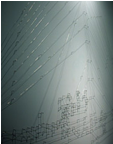
News
neuroTransmitter news: • Beyond Territory: neuroTransmitter -- Henry Art Gallery, Seattle, WA • Ground Control -- Dangerous Crossings, Ortstermine 2006, Munich, Germany • Frequency Allocations (in 3 parts) -– Contested Spaces: Artists and the Urban Environment, Pratt Institute, Brooklyn, NY.
Beyond Territory: neuroTransmitter :: November 10 – December 31, 2006 :: Henry Art Gallery, Faye G. Allen Center for the Visual Arts, University of Washington, 15th Avenue NE and NE 41st Street, Seattle, WA 98195-1410 :: Reception: Thursday, November 9, 2006, 8 – 10 PM.
The artist team neuroTransmitter (Valerie Tevere + Angel Nevarez) works specifically with radio machinations to investigate the history, technology, and current uses of this ubiquitous broadcast format. The two installations at the Henry situate our imaginations inside pirate radio stations of the past. 12 Miles Out, a wire drawing that functions as an antenna for an accompanying radio transmitter, depicts the blueprint of a ship that housed Radio Caroline, a mobile pirate station originating from the waters off the coast of Great Britain. The sound loop heard in the gallery is made up of fragments culled from archival materials originating from the mid-1960s heyday of offshore broadcasts.
Radio City 299-MW (1) refers to Radio City, a station based in abandoned military fortifications in the Thames Estuary off the British coast during this same era. The seven miniature models of the rampart-like towers contain the source of low-power transmissions relayed to the radios on the walls. The four-channel sound composition (also based on archival broadcast materials) occupies the gallery, replicating on a small-scale Radio City’s unauthorized occupation of institutional spaces – the physical architecture as well as the radio frequencies. Both pirate stations transmitted independent shows and rock music in defiance of the BBC’s government-controlled broadcasting monopoly and the heavy corporate sway over music programming.
By reflecting on the influential effects of these repurposed sites, neuroTransmitter proposes locating similar catalysts in our communities today. Their work, whether experienced in museums, over the airwaves, or in the public realm, suggests a reconfiguration of the broadcast spectrum as a space for communication and experimentation, where individual voice and locality take precedence over the homogenizing outcomes of regulation and corporatization. -Sara Krajewski, Associate Curator
Curated by Associate Curator Sara Krajewski and generously supported by the Paul G. Allen Family Foundation and ArtsFund. In-kind support provided by Hotel Max and Hogue Cellars. For more information call 206.543.2281. Contact: Betsey Brock, betsey[at]henryart.org
Ground Control: a project by neuroTransmitter is part of Dangerous Crossings, The Grammar of Tolerance, Ortstermine 2006, Munich, Germany :: 23 September – 19 November, 2006 in public places in the city of Munich/Germany.
Dangerous Crossings consists of twelve artistic interventions in public places in the city of Munich. The Dangerous Crossings projects are bundled into three thematic focal points: the first questions the eye-level at which the involved parties encounter each other, where the issue concerns tolerance. The second examines what is evaluated as a norm, how normalizing establishes and secures itself, and which means of securing are brought into play. The third focal point introduces self-techniques, with which those affected by this normalizing take control of their own situations.
Dangerous Crossings concentrates on two areas of Munich, from the city center up to the southern city boundary. It not only invites visitors to engage the artistic works, but to consider the path between projects. Each work of art offers itself as both a terminating point and intermediate stop of such a route.
A handbook is published by Silke Schreiber Publisher ISBN: 3-88960-087-5
Curated by Farida Heuck, Ralf Homann, Pia Lanzinger.
Artist interventions in public places in the city of Munich/Germany by: Beate Engl, Freie Klasse München, Alex Gerbaulet, Stefano Giuriati & Aldo Giannotti, GSA/Konrad Becker, Alexander Klosch & Oliver Thuns, Klub Zwei / Simone Bader & Jo Schmeiser, Andrea Knobloch, Folke Köbberling & Martin Kaltwasser, neuroTransmitter, raumlabor_berlin, RELAX, chiarenza & hauser & co
Organizer: Kulturreferat der Landeshauptstadt München Abteilung Kulturelle Veranstaltungen und Programme – Kunst im öffentlichen Raum
Contact: Erwin Hartel, Telefon 089/233254 53 erwin.hartel[at]muenchen.de
Frequency Allocations (in 3 parts): a project by neuroTransmitter is included in the exhibition Contested Spaces: Artists and the Urban Environment, Pratt Institute, Brooklyn, NY :: November 3–11, 2006.
The struggle for space is not a new issue among urban artists. The manner in which artists create work in spite of this struggle, however, is constantly evolving. The work, collaborations, collectives, and communities created are directly related to a common trend moving from traditional artistic methods into creative forms of cultural engagement. Some of the work actively addresses the question of what is art but we are posing the question what is the relationship of art to society. Artists in urban environments are often displaced from neighborhoods, pushed out of live/work spaces, and forced to persevere in extraneous circumstances. Many artists use their creative practices to reclaim their city and build communities. Historically there have been many reasons for artist to go to the streets, gentrification displacement being a common trigger, however, this is just one of many social concerns that artists address.
This exhibition deals with a cross section of artists currently working in New York City, but artists across the globe are finding creative ways to activate public space. This exhibition deals with individual artists and collectives whose work is related to concerns with social justice and whose efforts are typically displayed outside the traditional methods of exhibiting art. Our choice to represent here and now will show a real time view of artists reacting to many of the issues brought to the surface through the Art/Space Conference that this exhibition is presented in conjunction with Jim Costanzo & Brynna Tucker, Exhibition Co-Curators.
Participating Artists: Center for Urban Pedagogy, The Danger / Complacent Nation, El Puente, Ryan Watkins Hughes, neuroTransmitter, Not an Alternative, Michael Rakowitz, Duke Riley, Swoon, Lee Walton.
Essays by Alan W. Moore and Gregory Sholette
Curated by Jim Costanzo and Brynna Tucker
This exhibition is presented in conjunction with the conference Art in the Contested City, A Conference Exploring the Role of the Arts in Contemporary Struggles over Urban Space :: November 3, 2006 9 am to 6:30 pm.
For more information about the exhibition and conference
http://www.prattcollaboratives.org/
(1) Radio City 299-MW, commissioned by the Henry Art Gallery, is second in a series of works that examines the repurposed history, architecture, and sonic resonance of Shivering Sands, an installation of abandoned Maunsell Sea Forts initially used by the British military for fortification during World War II. Radio City was one of the pirate stations that occupied Shivering Sands during the 1960’s. For the first work in the series, entitled Offshore, neuroTransmitter consisted of Valerie Tevere, Angel Nevarez, and Lize Mogel. Offshore was produced while neuroTransmitter was in-residence at Eyebeam, New York.
neuroTransmitter
http://www.neurotransmitter.fm/
611 Broadway, Ste. 836
New York, NY 10013
Posted by jo at 02:22 PM | Comments (0)
October 19, 2006
Culture Catcher
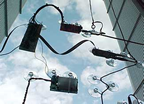
Lost in Translation
While driving through Africa, Michael Sheridan and his film crew met two men crouching in the sand and listening to handheld shortwave radios. The sounds from their radios reconnected the artist with the world after days of isolation and disorientation.
This experience inspired the sound installation Culture Catcher. Shortwave radios, digital recorders and players, motion detectors, micro computers, antennae... all the equipment required to search for and broadcast multiple shortwave radio signals is hung by suction-cups on a giant transparent wall.
The movement of visitors in the gallery triggers sounds from around the world which fill the environment. Simultaneously one might hear, for example, Persian music, Christian proselytizing and news reports in Korean, all affected by the interferences in the atmosphere. Via neural. [blogged by Regine on we-make-money-not-art]
Posted by jo at 08:28 AM | Comments (0)
September 01, 2006
Agent Radio
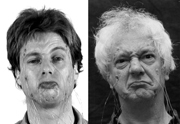
Automatic, Ongoing Soundscape
Agent Radio is an automatic radio station built around a computer with a broadband internet connection. The algorithm which runs the station downloads random sound files from the internet, and mixes them into an ongoing soundscape.
Agent Radio is one of the main projects taking place in the Department of Random Radio of the Institute of Artificial Art Amsterdam. The IAAA promotes the establishment of dedicated radio stations for the diffusion of sound-environments created by algorithmic music, physical processes, industrial machinery, randomly selected audio-documents, and arbitrarily sampled live sound. [via]
Posted by jo at 12:46 PM | Comments (0)
August 28, 2006
I Am(not)sterdam

10 Exercises to get the City out of your Body
Radio LIGNA / Radioballet / :: I Am(not)sterdam: 10 Exercises to get the City out of your Body :: Saturday September 2nd | 13.30 pm :: Radio Patapoe 88.3 FM and Radio Ruigoord 90.3 FM :: Location: Leidsestraat :: Bring your own radios and mobile phone receivers! :: Radio receivers also distributed at De Balie, Kleine-Gartmanplantsoen 10, Amsterdam.
Amsterdam Inc. - In the streets of Amsterdam, we are not only inhabitants or visitors of the city, but we also are part of a brand, that blends the individual being and the city into a common identity: 'I amsterdam'. There is no being in the city without being the city. The public sphere becomes the showroom for the new brand Amsterdam.
Deviant Behaviour - The appearance of the inner city as showroom is a product of sanitizing policies, eviction, surveillance and control. The latter is not only executed by police, and security personnel, but also by ourselves, as we have internalized modes of self-control and 'proper' behaviour. In the beat of the corporate city we confirm this logic by simply repeating the same set of fixed gestures again and again: walking around, stopping, looking in the shop windows, exchanging money for commodities. No rule is needed forbidding deviation: individual deviation is already part of the city branding.
'I amsterdam' means diversity. But what happens if we fail to repeat these gestures, and invent alien gestures on a collective scale? Can we, as inhabitants and visitors of Amsterdam, intervene in its regulated urban rhythm without becoming incorporated in the city's branding?
Radio ballet - The Radio Ballet 'I Am(not)sterdam' challenges you to find an answer! The radio ballet consists of a radio broadcast, especially produced for the Leidsestraat. It will suggest 10 different exercises to get the city out of your body. As a dispersed collective of participants, we perform deviant gestures (according to the script of the radio ballet), which would normally be impossible to do on an individual basis. Can we subvert the logic of the corporate city, by not subjecting ourselves to it anymore?
Come and find out! Be part of the Radio Ballet in the Leidsestraat on Saturday, 2nd of September 2006! I Am(not)sterdam! Dispersed collectivity instead of common identity! Don?t subject to the corporate city - become alien by public radio listening!
About Radio Ballet LIGNA
The free radio group LIGNA exists since 1995. LIGNA consists of the media theorists and radio artists Ole Frahm, Michael Hüners, and Torsten Michaelsen, who since the early nineties have been working at the "Freies Sender Kombinat" (FSK), a public non-profit radio station in Hamburg. In several shows and performances they have been investigating the importance of dispersal in radio as well as of the radio. One of the main focuses is to refer to forgotten and remote possibilities of radio use in order to develop new forms of interactive practices. Another emphasis has been placed on the development of concepts and the production of performative audio plays in order to find out how radio can intervene in public and controlled spaces, so that its public nature reappears in the form of uncontrollable situations
The “Radio Ballet” is an excellent example of the latter: it is a radio play produced for the collective reception in certain public places. It gives the dispersed radio listeners the opportunity, to subvert the regulations of the space. Held for the first time in Hamburg’s Central Station in 2002, this focused on how radio can intervene in public and controlled spaces, so that its public nature reappears in the form of uncontrollable situations. Yet, Ligna's performances aim to confront the privatised, controlled production of capitalism with the dispersed, yet collective, uncanny and public production of the radio. The Radio Ballet brought back excluded gestures of deviant behavior were invited to enter the station, equipped with cheap, portable radios and earphones. By means of these devices they could listen to a radio program consisting of a choreography suggesting permitted and forbidden gestures (to beg, to sit or lie down on the floor etc.). These suggestions were interrupted by reflections on the public space and on the Radio ballet itself.
The Radio Ballet I Am[not]sterdam, especially developed for De Balie, consists of a radio broadcast, produced for the Leidsestraat in Amsterdam. The radio broadcast will suggest ten different exercises to get the city out of your body. The dispersed collective of radio listeners will be able to perform deviant gestures that no one would or could do alone.
Is it possible to subvert the logic of the corporate city, if people do not subject themselves to it anymore? Come and find out! Become part of the LIGNA Radio Ballet in the Leidsestraat on Saturday, 2nd of September 2006!
The Radio Ballet starts at 14:00. You can get radios at De Balie from 13:30 on. But better bring your own radios, or mobile phones with receiver! The Ballet will be broadcasted on the Frequency of Radio Patapoe 88,3 FM.
I Am[not]sterdam! Dispersed collectivity instead common identity! Don´t subject to the corporate city - become alien by public radio listening!
Posted by jo at 10:03 AM | Comments (0)
August 18, 2006
MPG: Mobile Performance Group
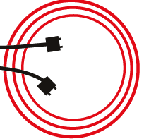
Art to Go
Founded by Matt Roberts, the MPG: Mobile Performance Group is a collective of new media artists interested in finding new ways to present art outside of traditional venues. MPG disseminates their work by using automobiles, video projection, cell phones, FM transmission, wireless hotspots, and any other technologies that allow artist to engage the public.
Parking Spaces investigates one of the most ubiquitous spaces in the United States, the parking lot. MPG moves through the city looking for empty parking lots to collect sounds and images. Using the collected material MPG creates an improvised performance in the space. Images from ZeroOne ISEA2006. Multi media feature from Mercury News. Flickr.
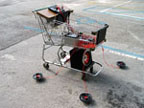
Shopping Carts: Using recycled cardboard, solar power, batteries and multimedia equipment, MPG converts shopping carts into modular performance units. During the day the carts are used to collect energy, sounds and images. Each cart is equipped with solar panels and batteries for energy collection. They are also equipped with audio/video recording equipment for sound and image collection. During the night carts carry panels, made of recycled cardboard, that allow several carts to connect and provide table space for the performers. The three basic carts are audio, video, and power. The audio module carries speakers, amps and mixing board. The video module carries video projectors, cameras, and lcd screens. The power module carries batteries, inverters and power strips to provide power for the performers.

Inflatables: A series of inflatables that can be used as performance space and projection screens. MPG is working with designer Gerry Christensen and a group of his students to create a series of apparatus for mobile performance. These apparatus include a bike trailer with a hybrid power source and wearables for performance space. The bicycle trailer is equipped with solar panels for energy collection and storage, and has the ability to tap into public power outlets. The trailers can cary multimedia equipment, local wireless network, and provide portable power. The wearable are portable devices that performers can wear to carry equipment and also convert into seating/table space for performance.
More information here. [thanks Craig]
Posted by jo at 10:29 AM | Comments (0)
July 30, 2006
Radio Vehicles
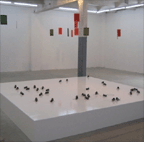
radio.territories urban intervention
Radio Vehicles with Darius James (USA/DE) and Peter Dennett, Art Yard (UK) :: Aliens Am Alex: radio.territories urban intervention at: TV Tower, Alexanderplatz, Berlin :: On Air 95,2 FM or online http://radioeinszueins.de :: July 30, 2006, 16:00 - 18:00.
Apocalypso: The Cosmic War Dance of Sun Ra's Army of Anthropodial Transistors :: When the composer and mystic, Sun Ra, returned to his native Saturn on May 30th, 1993, he left behind him a vast and varied body of recorded musical works. Up until now, much of this music was unreleased and unavailable to the public. But, through a series of séances conducted in the studios of Radio 1:1, with Dr. Snakeskin acting as medium, Mister Ra informed us that he will be returning to this planet in his astral form on Sunday, July 30th, 2006. He will not be alone. He is bringing his army of Anthropoidal Transistors. "We are going to invade Berlin!!!" he chuckled, "Our first target is the TV Tower in Alexanderplatz! My weapons?!! Two full hours of sonic attack—or acoustical magic -- taken from a secret library of unreleased recordings. We will dance a cosmic dance. A cosmic WAR dance. It's the Apocalypso!"
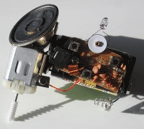
The working environment of the radio vehicles is the urban public space. Radio vehicles is an ephemeral urban intervention aiming to usurp urban space artistically. Twenty vehicles created from simplest and most affordable technical equipment will be let free into the wild. They move about while broadcasting the programme of radio 1:1 which will consist of unpublished Sun Ra material. The swarm moves awkwardly while emitting sound into the public space.
Proudly presented by the bootlab association in cooperation with radio 1:1 as part of the radio.territories series of urban interventions across Europe. Radio.Territories is supported by the European Union Culture 2000 Programme.
Posted by jo at 11:54 AM | Comments (0)
July 13, 2006
GLOWLAB 09: july :: august 2006

Networks, Mobility, Interventions
The projects in Glowlab 09 examine urban architecture by investigating the social spaces enabled by public networks, mobile communication devices and direct intervention. In viewing the work, one might re-imagine the city as space which is defined through the nature of the interactions that take place within it.

Public Broadcast Cart by Ricardo Miranda Zuñiga: Transforms a shopping cart into a mobile radio station, transmitting via miniFM and the Internet. The Public Broadcast Cart is designed to enable any pedestrian to become an active producer of a radio broadcast by reversing the usual role of the public from audience to producer.

Hundekopf by Brian House and Sue Huang (Knifeandfork): A location-based narrative project utilizing SMS text-messaging to explore the experience of riding the Berlin Ringbahn.

Relay: Toronto by Germaine Koh: An architectural intervention that turns a building into a sort of urban lighthouse, relaying text messages received on a mobile phone by flashing the building lights in Morse code.

Lee Walton's Western Shift by Allard van Hoorn: An open-environment collaboration between researchers, architects, designers, artist, curators and all kind of cultural producers. Its aim is to stimulate fresh ways of looking at urban living and discover alternative solutions.

SpeedWave by Otino Corsano: A photographic based performance piece inspired by the established location of a regularly monitored Toronto speed trap. A camera on a tripod replaces the laser gun to document waves of local traffic.

Talking Cities [magazine review] by Krista Jenkins: A review of the recently published Talking Cities magazine, the print accompaniment to the exhibition of the same name, taking place at Zeche Zollverein in Essen, Germany.
Glowlab is an artist-run production and publishing lab engaging urban public space as the medium for contemporary art and technology projects. We track emerging approaches to psychogeography, the exploration of the physical and psychological landscape of cities. Our annual Conflux festival, exhibitions, events and our bi-monthly web-based magazine support a network of artists, researchers and technologists around the world.
Posted by jo at 02:11 PM | Comments (0)
July 05, 2006
The MagicBook + The Book Radio
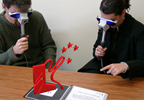
What's New in Books
The MagicBook explores seamless transition between reality and virtual reality. When users look at the pages of a real book through a hand held display, they are able to see virtual content superimposed over the real pages, that is augmented reality. When they see an augmented reality scene they like, users can fly into the scene and experience it as an immersive virtual environment. Currently the user can transition smoothly between these two fixed viewing modes: the augmented-reality view and the virtual-reality view.
The MagicBook also features functionality that supports collaboration: When several users look at the same book page they can see the augmented reality image from their own viewpoint. When one of these users decides to switch to the Virtual Reality mode and “fly” into the virtual model, the other users are able see him or her as a virtual character in the scene.
The MagicBook is created by the Human Interface Technology Laboratory New Zealand, part of the University of Canterbury in Christchurch, New Zealand.
Download a demo of the MagicBook software and check out the video. [blogged by Lene Mailund on Digital Experience]
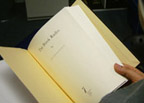
The Book Radio is a design project by Vinay Venkatraman & Pei Yu from the Interaction Design Institute Ivrea. The Book Radio appears to be a regular looking sketch book, but sensors and a microcontroller embedded in the spine allows its users to actually scan radio channels just by flipping the pages of the book. Book marking of radio stations and annotation of favourite programs by writing on to the relevant pages are also supported, and the volume can be changed by sliding the associated book mark.
The Book Radio is wireless and holds no screens, dials or buttons. Thus, the project is concerned with exploring the possibilities of creating intuitive and subtle interfaces.
Check out video 1 and 2 of the Book Radio. [blogged by Lene Mailund on Digital Experience]
Posted by jo at 08:48 AM | Comments (0)
June 25, 2006
BBC Radio 1
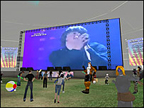
Talent-Spotting in Virtual Worlds
"...At Radio 1 we want to bring a new level of social interaction to our virtual broadcasts. We are hoping that the bands featured on-air will have their own custom-built avatars, playing in the virtual world. So if we have the Red Hot Chilli Peppers playing a gig, visitors to a Radio 1 virtual space will see avatars of Anthony Kiedis and Flea, mimicking the action in the real world.
We also believe it is crucial that the virtual audience can interact with the event. It is about replicating the "liveness" of an event, not just broadcasting it. Additionally, Radio 1 wants to find ways of allowing the audience in these worlds to actually affect the real event. I see no reason why they cannot be asking their musical heroes questions, alongside virtual Radio 1 DJs, either via Instant Messenger or VoIP. This deeper social interaction, that mirrors real world events, would do much to enhance the ripples that resonate around digital communities." From Talent-spotting in virtual worlds by Daniel Heaf, BBC.com.
Posted by jo at 03:14 PM | Comments (0)
May 19, 2006
SOLAR RADIO STATION

Sounds of the Universe
SOLAR RADIO STATION, a project by RIXC, Center for New Media Culture, Riga (LV) and r a d i o q u a l i a (NZ / AUS / GB / NL); PHOENIX Halle Dortmund; May 20 - July 16, 2006; Opening: Friday, May 20, 2006, 18:00.
In this (live) installation one can listen to the sounds of the universe originating from various sources. They have been collected by the artists' group r a d i o q u a l i a (Honor Harger, Adam Hyde) in cooperation with RIXC, Center for New Media Culture, Riga. The recordings are coming from various radio telescopes. Additionally, during two days, there will be live feeds from the VIRAC radio astronomy telescope in Irbene (Latvia) which will be acoustically re-worked and interpreted live by the experimental musicians Clausthome (Latvia). VIRAC is the largest radio telescope worldwide (with a dish diameter of 32 meters) accessible for civilian use - thanks to RIXC's continued efforts. During the cold war the KGB used the radio telescope for tapping into NATO's and other military networks.
The installation “Solar Radio Station" consists of three parts. r a d i o q u a l i a's computer and sound installation “solar listening_station" is the first part. It contains recordings and live streams of radio waves from space, especially from the sun. The second part “Spectrosphere" also contains signals originating from the VIRAC radio telescope, this time modulated via electronic instruments and interpreted visually. Here, Clausthome and VJ Ratniks present the results of their live performance from May 20 + 21 at PHOENIX Halle until July 16, 2006. The third part consists of a comprehensive video documentation of the VIRAC telescope by RIXC. Additionally, on a large scale poster the existing frequency spectrum is visualized and its current use is explained.
LIVE INSTALLATION: Sat + Sun, May 20 + 21, 2006, 19:00 - 21:00; The Riga based group Clausthome and VJ Martins Ratniks (F5/RIXC) will perform live in the Solar Radio Station. The live audio stream from the VIRAC radio telescope in Irbene, carrying data from the sun and from space, will be electronically enhanced by Clausthome and interpreted visually by VJ Martins Ratniks.
LINKS
www.museumamostwall.dortmund.de
www.hmkv.de
www.rixc.lv
www.radio-astronomy.net
www.virac.lv
A project by RIXC, Center for New Media Culture, Riga (LV) and r a d i o q u a l i a (NZ / AUS / GB / NL).
RIXC (LV) - Raitis Smits, Rasa Smite, Martins Ratniks, Davis Bojars r a d i o q u a l i a (NZ/AUS/NL/GB) - Adam Hyde, Honor Harger Clausthome (LV) - Lauris Vorslavs, Girts Radzins
In the framework of the exhibition "mit allem rechnen. Medienkunst aus Estland, Lettland und Litauen / face the unexpected. Media art from Estonia, Latvia and Lithuania" - a cooperation between Hartware MedienKunstVerein and Museum am Ostwall, Dortmund/Germany.
SUPPORTED BY: Kulturbuero Stadt Dortmund, 38. internationale kulturtage der stadt dortmund / scene: estland lettland litauen in nrw, Kunststiftung NRW, Der Ministerpraesident des Landes Nordrhein-Westfalen, Kultusministerium der Republik Estland, Kultusministerium der Republik Lettland, Kultusministerium der Republik Litauen, Botschaft der Republik Litauen in der Bundesrepublik Deutschland, Lietuvos Institutas, dortmund-project, LEG, PHOENIX, Medion, Coolibri (Medienpartner).
VENUE: Hartware MedienKunstVerein at PHOENIX Halle Dortmund, Rombergstr. / Ecke Hochofenstr. (no postal address!) Dortmund-Hoerde, Germany.
ADMISSION: PHOENIX Halle: 4 Euro, reduced 2 Euro (incl. admission to the exhibition "Glamour and Globalization") Kombiticket Museum am Ostwall and PHOENIX Halle: 6 Euro, reduced 3 Euro (incl. admission to the exhibition "Glamour and Globalization")
HOW TO GET THERE http://www.hmkv.de/dyn/e_contact_roaddescription/
CONTACT
Hartware MedienKunstVerein
Guentherstraße 65
D - 44143 Dortmund
Germany
Tel: ++49 - 231 - 823 106
www.hmkv.de
Posted by jo at 10:51 AM | Comments (0)
April 28, 2006
Radio_Copernicus Archives at Media Library/ZKM Karlsruhe

Radio Station gets a new Home
Radio_Copernicus Archives at Media Library/ZKM Karlsruhe: Starting on April 28th 2006, the audio archives from Radio_Copernicus, the independent and mobile German-Polish Artists Radio Station will be accessible to the public as a permanent exhibit in ZKM/Center for Art and Media Karlsruhe. Nearly the entire program that ran on air for almost six months from July until December 2005 in Polish, German and English can now be selected and heard at the Media Library at ZKM Karlsruhe. Not only is it possible to research artists, program content, background information, time slots and dates on site, but also on the internet (under www.radio-c.zkm.de). The visitors of the ZKM can lean back comfortably in the listening-chairs (by Dieter Mankau for documenta 8)at the ZKM Media Library and listen to the numerous artist's talks, readings, soundscapes, interviews, live-sessions as well as the 27 commissioned works of the artists radio station.
Under the direction of Professor Sabine Breitsameter (Professor of Experimental Audiomedia/Berlin University of the Arts) with the support of the Polish project-coordinator, Robert Gawlowski (University of Wroclaw), and a team of approximately 50 people, a program was realized this past year that until now had been unheard of on any other radio station. Related to current development in media arts and electronic culture, Radio_Copernicus dedicates itself especially to radio art, electro-acoustic art forms, live performances, new literature as well as current cultural and societal debates and discourses.
The main focus of the program is the 27 commissioned works given explicitly to chosen artists such as Robert Piotrowicz, Zbigniew Karkowski, Guy van Belle, ElletroVoce, Duo Merzouga, the artists group LIGNA, Stefano Giannotti. About 200 media artists, people who work in radio, producers, technicians, and organizers collectively developed Radio_Copernicus into a broadcast station that implements an innovative cultural radio concept. This has happened not only through its program content from pop to 'high culture', including the entire range of sophisticated artistic radio work, but above all through its unconventional discourse and presentation forms.
Professor Sabine Breitsameter, "The positive and enthusiastic reactions from artists and listeners show how great the need is for an innovative, and at the same time, artistically sophisticated radio on both sides of the border. Because the audio archives of Radio_Copernicus will be open to the public regardless of the broadcasting time in ZKM, our project gains in having a long-term effect."
Radio_Copernicus, the independent German-Polish Artists Radio, ran from July 15th till December 31st 2005 on local and temporary FM frequencies as well as worldwide via Live-Stream in German, Polish and English 24 hours daily. The mobile station operated between the two neighboring countries. It moved from its first location in Stralsund (July/August 2005) to Warsaw (September 2005), then to Berlin (October 2005) and finally to Wroclaw (December 2005). Radio_Copernicus cooperated with the garage Festival in Stralsund, the Warsaw Autumn, the series of events, Dis_Positionen (Academy of the Arts Berlin) and Talking Back to Radio Radio as listener at the University of Wroclaw as well as at numerous local institutions.
Radio_Copernicus was based at Berlin University of the Arts (UdK) (Experimental Audiomedia/Sound Studies) and collaborated the Department of Journalism and Social Communications at Wrocław University/Poland. The project took place within the framework of Büro Kopernikus. The Büro Kopernikus is an initative of the Kulturstiftung des Bundes (Federal Cultural Foundation).
Head of programme and artistic director: Professor Sabine Breitsameter Project coordination in Poland: Robert Gawlowski Editorial Staff: Thomas Schumacher und Katrin Werner Production, editing and hosting: Martin Conrads, Thomas Doktor, Olaf Matthes, Jacek Skolimowski, Marta Sztanka, Sebastian Weiß, Adam Witkowski, Database and programming: Sebastian Weiß Sound Engineer: Domenico Utpadel
The publication of Radio_Copernicus is immediately available at book stores for 15 Euro. Radio_Copernicus. The German-Polish Artists Radio ISBN: 3-89462-138-9
Posted by jo at 11:44 AM | Comments (0)
March 03, 2006
Taking The Time For A Walk
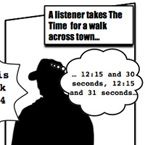
Between Performer and Radio Time
This project is an adaptation of Time Server which was first performed for the Foundry's Late Late Breakfast Show, broadcast in London on Resonance 104.4FM between midday and 1pm on July 22.
The work entailed Simon Pope walking from the NTP (network time protocol) server at University of London Computer Centre in Guilford Place, London, to the Foundry in Old Street, London, 'taking the time' and delivering it to the radio show from where it was broadcast live on FM radio. The aim of the work was to investigate the interaction between 'clock time' and 'circadian time', using radio broadcast's conventional standardized time as a gauge.
In Taking The Time For A Walk--by Simon Pope in collaboration with The Foundry--a radio broadcast of 'clock time' is 'returned' to the Foundry's radio show. Simon Pope will walk from the line of the meridian as it intersects London, 'talking the time' with him as he goes; this 'time', as moderated by the 'body clock' and movement of the performer, then becomes the standard time that the radio station uses in its radio broadcast. [a NODE.London event]
Posted by jo at 10:56 AM | Comments (0)
February 01, 2006
Tempest For Eliza
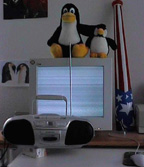
Observe without Touching
Tempest for Eliza, by by Erik Thiele, is a program that uses your computer monitor to send out AM radio signals. You can then hear computer generated music on your radio. You need no additional hardware to understand that it is really possible to observe your computer without physically touching it. (tempest). I wrote this program because it was fun and because it teaches in an amusing way that tempest really exists. I want people to understand that their computers can be observed. And last but not least you can listen to music without a soundcard!
How does this work? All electronic devices send out eletromagnetic waves. So does your monitor. And your monitor does it all the time at very high frequencies, high enough for your short wave AM radio. All you have to do is display the "correct" image on your screen and your monitor will emit the "right" signals. Tempest for Eliza displays pictures on your screen, one for
each note in the song.
Posted by jo at 08:11 AM | Comments (0)
December 05, 2005
New on Audiohyperspace
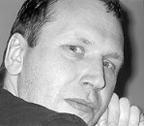
"free lutz!" by Johannes Auer
Dec 8, 2005, 7 p.m. CET, Berlin: FM 95.2 - Wroclaw/Poland: FM 91.3
The stochastic texts by the German mathematician Theo Lutz from the year 1959 are considered being among the milestones of computer-generated poetry. Stochastic texts are texts whose words are defined by chance. Sentences ort parts of sentences are selected by chance operations and are put together to form a language continuum. The free lutz! radio project by Johannes Auer, one Germany's best-known net artists, is based on reprogramming the original pioneering work. A web interface allows listeners to influence the generation of text both at the gallery and on the Internet. The listeners can participate in generating the text, done by the machine, via a web interface. Together with the computer, the listeners will create the textual basis of the live program, during which a speaker will "stage" in real time the computer poetry. Text input is possible in German and Polish.
http://auer.netzliteratur.net/copernicus/ http://www.swr.de/swr2/audiohyperspace/engl_version/interview/auer.html
Also New on Audiohyperspace
Posted by jo at 11:53 AM | Comments (0)
November 23, 2005
Slowscan Soundwave (III)
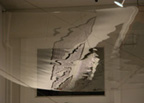
Sonic Presences
The sound has always been 'immaterial' (well before the digital data), and it has always fascinated our perceptive apparati, because of its fleeting 'presence'. The sonic presence, in fact, organically is revealed through the eardrum vibrations and in the consequent electric signals sent to our brain. This is a common theme the sonic artists love to play with, till its essence, that is the remaining senses' perception of the sounds around us. Slowscan Soundwave (III) by Douglas Irving Repetto is an installation made with long semi-transparent polyester (mylar) strips that moves accordingly to the environment sounds, through a system made out of motors, strings and pulleys. These strips are illuminated by soft lights and so they generates shadows and reflections, moving unanimously, emulating a complex system moved by frequencies. The ethereal transparency and the strips' vibrations in waves materialize the abstract representation made by sinewaves in audio software. The atavic processes of the sounds' transmission through the air are reproduced with analogic mechanic tools, after being made public through the digital interfaces. [via neural.it] [Related]
Posted by jo at 10:22 AM | Comments (0)
November 14, 2005
Radio_Copernicus

Talking Back to Radio
Talking Back to Radio--Radio als Zuhörer Artyści zmieniają radio: Workshops, Installations, Interventions, Netperformances, Concerts and Symposium in Wroclaw; December 6th - December 11th, 2005.
SYMPOSIUM: “Radio – one speaks without being able to hear and many hear without being able to speak.” With this sentence, German media theorist Rudolf Arnheim criticized what he saw as the absurd paradox of radio in the 1930s. As long as radio operates as an one-way broadcast, it allows for no spontaneity. At best, it can serve only as a restricted and highly circumstantial form of communication. Echoing Arnheim’s criticism of the medium was German playwright Bertolt Brecht. Both men wanted to transform radio into a two-way medium, and in doing so close the circle of communication between listener and broadcaster.
The Radio_Copernicus series “Talking Back to Radio – Radio als Zuhörer – Artyści zmieniają radio” takes this concept and applies it to art. What connection do artists have to radio? How does radio change if it adopts aesthetic criteria? To what extent does the medium need to change its image and position in society to be a vehicle for innovative, artistic developments and, as a concequence, develop an advanced radio culture?
Radio_Copernicus organizes an international symposium at the Universiyty of Wroclaw, which examines the subject "artist radio" from different perspectives.
WORKSHOPS: What happens to radio, if artists take control? What is happening to the medium if it ignores the paradigm of marketing, news broadcasting and power rotation playlists? A wealth of alternative “radio activities” by engaged professionals around the world demonstrate that such a radio is conceivable, feasible and in demand. Radio_Copernicus provides a open forum to discuss possible answers to these questions -- not only in its programming, which is open to any form of radio art, but also in dedicated workshops. One such opportunity is offered by the international symposium “Talking Back to Radio”, to be held in Wroclaw, Poland, at the beginning of December. Those taking part in the event will discuss the key issues in the relationship between radio and art, and will receive practical, hands-on guidance from renown radio professionals.
The four workshops will take varying thematic approaches. The results will be presented by participants and their workshop supervisors at the international symposium “Talking Back To Radio” (18:30, Saturday, 10.12.05).
Workshop 1: Free Radio: A Media-Simulation in Three Days with Thomas Kupfer and Lukasz Smigiel
Workshop 2: Soundwalking From the Ear to the Radio Broadcast with Hildegard Westekamp and Lukasz Szalankiewicz
Workshop 3: LIGNA – Radio Art as Intervention and ‘Counter-Public’: Uncontrollable Situations, Unpredictable Productions with Ole Frahm and Torsten Michaelsen
Workshop 4: What is Radio Art? Artistic Approaches in International Comparison with Sabine Breitsameter and Robert Gawlowski
Parallel to the workshops is a nightly program of installations, net performances, concerts and radio plays at BWA Municipal Gallery/Wroclaw. The international symposium “Talking Back to Radio – Radio als Zuhörer – Artyści zmieniają radio” takes place from December 10 – 11. Admission is free in each case.
Posted by jo at 09:33 AM | Comments (0)
November 03, 2005
On the BBC Annotatable Audio project...
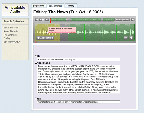
Towards User-Created Annotation and Metadata
"...The project we undertook was focused on Annotatable Audio (specifically, but not exclusively, of BBC radio programming) - and we decided to look in an unorthodox direction - towards the possibilities of user-created annotation and metadata. We decided that we wanted to develop an interface that might allow the collective articulation of what a programme or speech or piece of music was about and how it could be divided up and described. Our first ideas looked for approaches similar to del.icio.us, Flickr or our own Phonetags - which create collective value by accreting the numerous annotations that individuals make for their own purposes. But after a fascinating discussion with Jimmy Wales, we decided to think about this in a different way - in which (just like Wikipedia) individuals would overtly cooperate to create something greater and more authoritative..." From On the BBC Annotatable Audio project... by Tom Coates, plasticbag.org.
Posted by jo at 11:04 AM | Comments (0)
October 31, 2005
PDradio
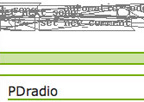
A Self-Regulating Virtual Radio Station
PDradio, transmitting computed sounds in Pure Data format. The definition of streaming 'radio' involves a fundamental difference with respect to traditional radio, that is, the possibility to organize a deterritorialized and computable flow of sound data. The PDradio project, by Winfried Ritsch and Georg Holzmann, makes this possibility concrete. This radio station transmits Pure Data files uploaded by the audience and selected by a software-dj compiled in the code. This artificial entity also announces the pieces using voice synthesizing functionalities, telling the file name and the associated metadata, sprinkled with impromptu communications. If a user shows his appreciation for a piece, the dj will generate a personalized playlist. PDradio runs on a Linux server with the programs Zope and Plone and the calculated music follows the composition scheme, that is, the rules of this ductile tool, aesthetically reflecting them in the loops used in its compositions. It's pure electronic music with a wide range of styles, but which can't detach itself from machinic frequencies. If we may talk of 'genre', it abstracts the usual musical style categories to trascend into a style of composition, recursively widening its concept. [via neural.it]
Posted by jo at 10:38 AM | Comments (0)
October 22, 2005
Curated by
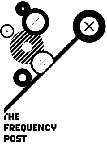
Frequency Post
Frequency Post is comprised of six generative sound works, each an investigation of radio frequency allocation as defined by the broadcasting legislations, technologies and economic pressures brought to bear on each of countries and/or regions individually commissioned sound artist/composers choose to draw inspiration from.
Frequency Post is a curated series of broadcasts, each 35 minutes in length, with the first piece to be performed live-to-air in Vienna by Andrew Garton, the projects curator, on the 23rd of October 2005. The notion that the spectrum is much like "the nervous system in a living organism" is at the heart of the generative processes each of the artists are to employ in the design and construction of their works. Commissioned artists include the well respected, long-time composer, Warren Burt, the infamous and inspiration for much of Australia's electronica genres, Ollie Olsen, award winning sound artist and performer, Steve Law, emergent sound and recording artists, Lie, Pei-Wen from Taiwan and Jin Shan, mainland China. Commissioned by KunstRadio (Vienna, Austria) for Curated by, an on air and online exhibition of international radio-art.
Posted by jo at 05:40 PM | Comments (0)
September 29, 2005
Free Radio SAIC
![]()
Special Broadcast w/Eric Leonardson & Inge Hoonte
Friday, September 30, 1:00 PM--2:00 PM (GMT-6/US Central Time). Listen on-line to the live audio stream, QuickTime required.
This 1-hour webcast--by students of Eric Leonardson and Inge Hoonte's First Year Program Core Studio Time Group at The School of the Art Institute of Chicago--is the result of 13 individual site investigations of specific city spaces in the downtown Chicago area. All sounds and voices are produced through a month-long process of mapping, scoring, field recording, historical research, writing and improvisation. References for this project include the ideas and works of R. Murray Schafer, John Cage, Robert Smithson, John Smith, Graeme Miller, Goat Island, and Inge Hoonte.
Phone in. Studio: 312-345-3804; on-air: 312-345-3805. Past radio performances and more can heard in the Free Radio SAIC archives .
Posted by jo at 08:45 AM | Comments (0)
September 26, 2005
Radiodays:
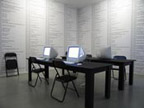
When Viewers Become Listeners
Radiodays is a temporary radio station. Realizing a listening exhibition rethinks ways of art presentation. By using an auditive format, artistic works are presented within a space in succession of each other rather than simultaneously: they appear, disappear and reoccur. The choice of using radio at the same time attempts to give a voice to an actual concern towards the auditorial found in many works by visual artists.
Radio and its non-visual message offers creative resistance to the retinal spectacle that surrounds us. It has been said that radio is dying. But one could also say that radio is highly topical; an old, nostalgic means of communication, a pre-modern dream, a modernistic reality, a strong tool for connecting people, for bridging distances. With its outdated technological capacity and low-fi communicational power, radio is distinct from other high-tech and high-speed commercialized mediums that are highly influenced by the capitalist sphere of interest. Commercials, billboards, TV culture, and big screens on the street are also part of retinal consumption. Looking is a way to experience the omnipotence of the “society of spectacle”. Closing one's eyes is becoming an act of civil disobedience.
Artists and theorists are invited to produce new works, lend existing works or interpret them specifically for the radio broadcast. The project wants to investigate the relationship between hearing and imagination, processes of translation. Broadcasting live from inside De Appel, the exhibited works are not limited to the physical building. Art is coming home and can be enjoyed in private surroundings rather than only within the physical exhibition space.
Thus, the exhibition space is considered as the base for live debates and (inter)action. This radio “show room” will act as a driving force to materialise an audience. By treating radio as an alternative space, we open many others: medium-specific space for medium-specific art, space for interactivity, cooperative space, space for discussion, and space for negotiation. During Radiodays every listener becomes a dynamic and transformative carrier, a conceptual space of possibility and experimentation. As a non-material medium, radio brings a new potential to participants and audience by immediately bridging distances. Referring to the successive way of presentation — like in a movie theatre — Radiodays can be seen as a “cinema for the ears”. What do we see when we listen to the work?
Posted by jo at 06:00 PM | Comments (0)
September 13, 2005
0kn0
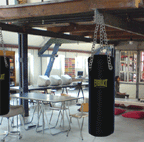
Looking Glass
0kn0.org is a new interdisciplinary media center for art and technology in Brussels. 0kn0 supports the research, development, creation and presentation of new forms of innovative cultural production, and is dedicated to exposing broad and diverse audiences to new technologies and media arts through a programme of concerts, interactive installations, performances, workshops and lectures.
OKNO presents BO-KU-SHI-N-GU BA-GU [Electronic Boxing Bag Melody Making Machine], an interactive installation by SWUMMOQ.NET [Heerko van der Kooij/nl and Niels Wolf/de in collaboration with Travis Robertson/ca]. Punching the Bokushingu Bagu the visitor generates and composes melodies from a selection of various sounds depending on the power and area of the punch. The visitor applies great effort only to be hindered by the outcome of his intensity.
Opening performance by swummoq.net: friday 16 september 8pm-10pm or try it yourself on: Saturday 17 September 2pm-6pm; Sunday 18 September 2pm-6pm; Entrance free.
radio_okno is online now! click: http://qt.okno.be:8000/mix.m3u to open the livestream in your mediaplayer.
Masterclass on Synthetic Speech and Machinic Sound Poetry. Participants can still apply. The masterclass is scheduled from October 17-21 and is part of the x-med-k-2005/series, commissioned by the VAF [Vlaams Audiovisueel Fonds].
OKNO: koolmijnenkaai 30/34 quai aux charbonnages | brussels 1080 | belgium
tram 18 [walvis] | Metro Graaf van Vlaanderen - Comte de Flandres
okno is supported by the Ministry of the Flemisch Community and the VGC.
Posted by jo at 11:41 AM | Comments (0)
August 30, 2005
UserRadio
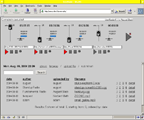
Spreading the Space of Radio Production Amongst its Listeners
"Abstract: Userradio mixes the new technologies of personal communication with "old'' broadcast radio technology. It is a set of tools for collaborative networked audio production, where an unlimited number of individuals can mix multiple channels of audio simultaneously and together from anywhere on-line using a standard flash-capable browser. The audio output of the application is broadcast on terrestrial FM radio and the users are ideally within the broadcast diameter." From Userradio by August Black.
Posted by jo at 08:22 AM | Comments (0)
August 25, 2005
Radio_Copernicus@Warsaw_Autumn 2005

World Premiere + Open Studio
Radio_Copernicus@Warsaw_Autumn 2005: After the prelude in Stralsund Radio_Copernicus - the German-Polish Artist Radio- is broadcasting for another month in co-operation with Warsaw Autumn 2005, the 48th International Festival of Contemporary Music: September 01-30, 2005 live-stream; September 16-30, 2005 on air: Warsaw FM 92.4.
With its ambitious programme Radio_Copernicus creates a broad discourse and context regarding Warsaw Autumn 2005 - to focus on innovative media concepts and art and culture of the electronic age. Besides regular reports and discussions on Warsaw Autumn the broadcast of Radio_Copernicus-commissioned works is a highlight of the programme: six up-and-coming artists are invited for the world premiere of their productions - Duo Merzouga, Anne Koenig, Michal Jacaszek, Emiter/Aszyn, Group Two, Underwater Agents. Almost daily from 10 pm to midnight Radio_Copernicus - broadcast-studio in Warsaw will be committed completely - as an "Open Studio" - to the artists and their visions of radio.
Further on-air stations of Radio_Copernicus:
Dis_Positionen, Academy of the Arts, Berlin - November 2005
International Radio Art Symposium, Wroclaw - December 2005
Radio_Copernicus is broadcasting permanently and world-wide as an
Internet-live-steam until 31 December 2005 on www.radio copernicus.org.
Further information can be found in Polish, German and English here:
Studio Radio_Copernicus
University of the Arts Berlin
Postfach 120544
D-10595 Berlin
Tel. +49 30 3185-2482
Fax +49 30 3185-2530
Email info@radio-copernicus.org
http://www.radio-copernicus.org
Posted by jo at 07:33 AM | Comments (0)
August 23, 2005
Trans Siberian Radio

Mobile Lab for On-Air Experimentation
Trans-Siberian Radio is a low-power FM station that will operate on the train from Moscow to Beijing via Novosibirsk, during the conference Capturing the Moving Mind: Management and Movement in the Age of Temporary War, September 11–20.
The station will be a mobile lab for on-air experimentation, featuring music and ideas created collaboratively by passengers on the train and accessible to everyone along the Trans-Siberian route. As curator Natilee Harren writes, the ever-moving symbol of the train fits the conference's theme: "The spirit of the conference is to cross fixed boundaries and to create an environment that is open to the 'contaminating influences' of the communities through which the train will pass. In fact, the point of having the conference on a train is to escape any restrictions relating to a particular time or place." Visit the project's site when the train is rolling to contribute with audio works or hear—and manipulate—audio clips from the ride. [blogged by Regine on we-make-money-not]
Related: "Last year, artists Jennifer Allora and Guillermo Calzadilla used micro-radio transmitters to create a re-volt. That is, by helping community members build nearly 500 micro-radio transmitters, they initiated a process by which power was redirected from the corporations who most profit from the publicly owned airwaves to individuals who can express a diversity of commercial-free viewpoints. Their project Radio Re-volt , created during a residency at the Walker Art Center, culminated in October with a narrowcast the length of University Avenue in Minneapolis. More than 50 micro-radio stations aired from homes and businesses along the route for the benefit of their neighbors or anyone driving the avenue with their radio on." ...More on Radio Re-volt at WiredNews. Click here to read an interview I did with Allora and Calzadilla last spring. [posted by Paul Schmelzer on Eyeteeth: A journal of incisive ideas]
Posted by jo at 10:35 AM | Comments (0)
August 05, 2005
Air Vent: Call for Participation

The Relationship Between Sound and its Source
AIR VENT is a project that takes natural sounds out of their specific location, the sounds of peoples personal spaces [via mobile telephone] & places them live via radio senders or the internet into new contexts, into diverse locations, into both similar & contrasting environments.
The work stems from ideas based on the relationship between sound & the sound source; natural rhythms & patterns in everyday sound [background noise, dialogue, etc]; the fine line, & often friction between natural & synthetic sound in connection to space; audio & visual perception.
Air Vent is radio/telephonic project by k donovan for Radio LoRa in Zürich that will start on 1st august at 00:00 & end on 10th august at midnight. Five minute snippets of sound will be transmitted hourly for those 10 days, both pre-recorded & live via mobile/landline/internet phones from around the world. The idea is to take the background sound from a specific space & relocate it (mainly live) into other new, similar & contrasting environments through radio.
If you are interested in sharing the sound from your space live, you are gladly invited to participate by registering online & providing dates & times when it would be possible to call the studio in zürich, or connect via internet phone. You will then be contacted (via sms or email) with a confirmation.
Pre-recorded sound files (preferably recorded with a telephone, but other ways are also acceptable) of environmental/field recordings can be sent to:
spezialprogramm@lora.ch (mp3's) or by snail mail (be quick!) to: AIR VENT, Alternatives Lokalradio Zürich, Postfach 1036, CH-8026 Zürich, Switzerland.
Please include a short introduction about the place and time at the start of the recording.
Queries & questions? Contact: kdonovan_uk[at]yahoo.co.uk
Things to acknowledge: For live calls, don't forget time differences! The concerns of this project are the 'natural' background noises that are specific to a certain space/time/situation.. therefore, participants are asked to simply use their phone to transmit their given environment through sound, rather than to perform or contrive something for the listeners. And by the same token, pre-recorded pieces that have not be edited/layered/effected would be preferred.
Posted by jo at 10:20 AM | Comments (0)
August 04, 2005
Sending and Receiving
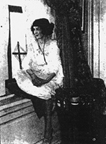
The matrix...net of all nets
"...Indeed, radio — and therefore the beginning of all electronic mass media — is invented by receivers, not by broadcasters. One might modify Duchamp's famous quote that the onlookers make the pictures: "Ce sont les récepteurs, qui font les médias." And even though today it seems as if the broadcasters alone possessed all power over the mass media, there is an almost anarchical criterion, on which all is based and in which the power of the receivers has been preserved: In TV ratings are everything.
How could the power of the receivers be great enough to turn the entire media machine upside down and change it from a strategic into a distributive system? What fascination initiated all that constitutes our present-day electronicized worldview?..." From Sending and Receiving by Dieter Daniels, tout-fait, issue 2. [via]
Posted by jo at 12:06 PM | Comments (0)
Radio_Copernicus

Commissioned Works
Radio_Copernicus @ garage, Stralsund, July 15th – August 21st on 93,0 FM Stralsund. Commissioned works:
Radio the Receiver by Robert Piotrowicz: Wednesday, 27.7.2005, 20.30. "Radio the Receiver" is an electro acoustic composition, which works with sounds, which are lost in the linearity of radio transmission. Besides all the voices and stations on the ether there are sites of fracture of technical perfection, which are adopted by Robert Piotrowicz. Where the listener can’t influence the transferred signal or can elude the signal only by leaving the wave band itself, "Radio the Receiver" transforms the passivity of the radio listener into a process of creation.
"Radio the Receiver" creates a new ether made up of unidentified noises, distorted transmissions and those particles of the transmission signal, which do not contain information. The soundscape recordings are partly processed with an analogue modular Synthesizer, partly left in their shape. The composition distillates a narration from the infinity of information, which is contained in the radio signal, a narration which gives voice to the therein hidden and to the aesthetics of the sounds, the signals and their dynamics.
Two Way Radios (2WR) by Guy van Belle: Thursday, 28.7.2005, 20.30--“Two Way Radios (2WR)” is a project of the Belgian Guy von Belle, who develops multimedia-technologies for artistic use since 1990. He works with several bi-directional audio streams for “2WR”. Four performers (Guy van Belle, mxHz.org, Akihiro Kubota, Tokyo, Barbara Huber, Linz, Aymeric Monsoux, goto10.org Rotterdam) generate and mutually change their 4 Livestreams and thereby tie up to the manifold history of artistic radio utopias. In spirit of these utopias radio shall create a simultaneous connection between the here and the elsewhere, establish communication and response in both directions. [Related]
The Future Of Radio Art by LIGNA: Friday, 29.7.2005, 16.00--The group LIGNA from Hamburg designs experimental situations, which use the potentials of radio that are inherent to this medium, but which are forgotten and ignored. With “The Future of Radio Art” the radio-activist group conceives a 55-minutes radio play, which works at the same time as a discourse on radio and as a performative intervention in public space. The radio play (German/English) broaches the issue of “radio” and is about that listening to radio always changes the situation in which it happens. It deals with the constellation of listeners created by radio and the potentials of these constellations. It will recommend simple exercises to the listeners to help them to comprehend these potentials of radio. The performative part takes place in the pedestrian area of Stralsund. There the broadcast becomes audibly scattered and thus the acoustic situation in public space is changed.
P. und Wolf (Die Theorie des Durchschnittlichen) by Tomasz Gwiñciñski. Wednesday, 3.8.2005, 20.30--Tomasz Gwiñciñski ties in the Polish tradition of readings and radio plays with “P. und Wolf (Die Theorie des Durchschnittlichen)“ (P. and the Wolf. The Theory of the Average). It is a musical fairy tale, which is assembled on dialogues between instruments, but refers also to the use of voices and noises in old Polish child records published in the 70's and 80's as sound radio plays. The pre-produced composition is realized by a chamber orchestra, Elektronica and a voice. Krzysztof Gruses "Die Theorie des Durchschnittlichen" contributes the text basis.
Der Versuch über etwas anderes als mich selbst zu sprechen by Marc Degens/Jarek Grzesica: Tuesday, 9.8.2005, 20.30--"Der Versuch über etwas anderes als mich selbst zu sprechen" ("The attempt to speak about something else than me"), a text by the Berlin author Marc Degens meets the sound world of the Polish sound artist Jarek Grzesica. The text tells three small episodes of the childhood of a boy in the 70's/80's. In three situations the boy meets other people on the roads or in his neighbourhood. Obviously these meetings play an important role in his growth. Recordings of the text in German, Polish and English are the basis of Jarek Grzesica's work, who arranges three versions and integrates them into his sonic material.
Energistic Radio by Michal Górczyński, Jan Duszyński, Tomasz Duda; Wednesday, 10.8.2005, 20.30--The radio performance “Energistic Radio” is a 50-minutes cooperation of the young polish composer and improviser Michal Górczyński with the composer and interpreter Tomasz Duda. What begins sonically as an abstract radiostudio, develops into a piece of improvisation, whose scenario is based on Michal Górczyński’s „Energistic Manifesto”. Inspiration from different music directions, noises of everyday life and the sonic characteristics of certain geographic areas are processed in a way, that the listener is able to recognize already well-known within the plentitude of the sound material. According to the „Energistic Manifesto” this happens on a level, which wants to approach to the sources of inspiration on an emotional level. „Energistic Radio” merges thereby the listener into the sound world of the medium radio in a subtle way and creates connections beyond an attitude of perceiption, as it is promoted in format radio: being only offered sounds which could easily be deciphered.
Posted by jo at 11:14 AM | Comments (0)
August 01, 2005
Ruccas.org
![]()
As Good as the Community Makes It
Today, Ruccas.org celebrates the end of its first year of operation, and the start of the next. A year ago, ruccas.org launched with a handful of artists. Today, it features the works of over seventy artists and collaborative projects, nearly all of which are available under a Creative Commons license.
Its growth and success are due entirely to the community, who have taken advantage of how easy it is to add their own page and share their work with one of the largest online audiences for unconventional electronic art. Ruccas.org's allowing of anyone to edit the site and add their own pages, as well as its offering of free hosting for aural, visual, and software art, has enabled this to happen. The ruccas.org philosophy is that the best way to create a site of this type is to give the community as much control as possible, and artists from all around the world have stepped up and proven that our philosophy is correct.
In the coming year, I personally hope that the site will continue to grow at the rapid rate it has been. Ruccas.org is a unique hub in the sense that is it only as good as the community makes it. Therefore, I urge all of you out there who are are trying to do something "new" to come share your artwork with us, and to encourage others to do the same. I know that I speak for the entire ruccas.org community when I say that we're looking forward to the next year of new additions, new directions for the site, and new community members.
- John Nowak, Ruccas.org
Posted by jo at 08:20 AM | Comments (0)
July 29, 2005
New on AudioHyperspace

Two Way Radios [2WR]
"Each receiver a potential transmitter". It was not only Hans-Magnus Enzensberger who imagined radio as a two way medium: Brecht's dictum of "radio as an apparatus for communication" is more than famous. Freeing radio from its centralized and mono-directional broadcast structure has been a strong claim since radio's early days. And it has been especially the Internet, which made two way radio-structures become a serious possibility.
Based on the thoughts and utopies of Brecht, Enzensberger, but also on "La Radia" by F.T. Marinetti and Pino Masnata, the Belgian sound and media artist Guy van Belle created his series of performances Two Way Radios [2WR]. Premiered in Prague on April 14, 2005 this set-up of sound and communication architecture was performed in a new version on "Radio_Copernicus", a German-Polish artist radio on July 28, 2005. Several bi-directional audiostreams, generated by four performers (Guy van Belle and Barbara Huber in Stralsund, Akihiro Kubota in Tokyo, Code 31/Okno Brussels) were mutually altered within this group. [more]

Early Sonic Networker: Guy van Belle
"Sabine Breitsameter: Guy, you have been a sonic net artist long before the internet became popular for a general public. When was your first sound work you did with the net? When did you start?
Guy van Belle: I think the first time we used a network, which was already a TCP/IP network, was in 1992, and the reason why we did it was actually that I was part of a composers' band called "Young Farmers Claim Future". Basically we were two people, that was me and Herbert van de Sompel. He is now a researcher in Los Alamos. But he was working at a library as head of the automatization of library, and I was at that time working at an educational department, it was a research project about literature and technology from an educational background." Continue reading Early Sonic Networker: Guy van Belle in Conversation with Sabine Breitsameter.
Posted by jo at 08:33 AM | Comments (0)
July 18, 2005
Book Radio

Frequency Flipping
Vinat Venkatraman and Pei Yu's Book Radio takes the mental model of a physical book where user can browse by flipping pages, read by keeping a page open, and create a reminder of a specific page by placing a bookmark.
Each page of the Book Radio represents a frequency. You flip pages to scan the frequency spectrum; open to a specific page to listen to a station; place the bookmark on a desired page to listen and store the station; and slide the bookmark up or down to control the volume. Besides you can scribble in it, place stickers or take notes while listening. Videos. [blogged by Regine on we-make-money-not]
Posted by jo at 10:35 AM | Comments (0)
June 28, 2005
Tune Me
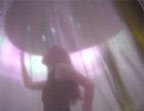
Multi Sensorial Radio
Tune Me is an immersive conceptual radio based upon tactile features. The sound and the visual are triggered by "touchy" interfaces. The visitors enter the ellipse-shaped space, immersing themselves in a new world where to listen to the radio waves.
As well as the sound, each channel provides light features as well as vibrating and pulsing experience. When choosing the different FM stations, the overall space changes, defining different moods upon the nature of the different content. News, sport, classical music and international pop. Each of them triggers a different visual experiences, the space vibrates, pulses and interacts with the visitors.
Developed by Line Ulrika Christiansen, Stefano Mirti and Stefano Testa (with Daniele Mancini and Francesca Sassaroli). More pictures by Stefano and Simone. Also part of Touch Me at The Victoria & Albert Museum (London) till August 29th 2005. [blogged by Regine on we-make-money-not]
Posted by jo at 08:18 AM | Comments (0)
May 31, 2005
Across-Offshoot
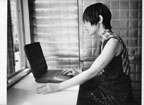
Interaction as Pure Sound
Across-Offshoot--by Keiko Uneshi (o.blaat)--was recorded and broadcast by ORF radio in Vienna in April of 2005. In the words of the artist it is an ‘acoustic laptop’ recording with radio and laptop computer interaction as pure sound. One of these pure sounds became the feedback that Keiko Uenishi, aka o.blaat, used for her radio piece “across-offshoot.” The artist used a portable radio to create feedback in the laptop speaker. As we listen we hear airwave communication between two everyday devices – laptop and transistor radio – in the form of feedback off the FM carrier frequency. Listen to Across-Offshoot (.mov)
Brief Bio: Based in Brooklyn, New York, sound artist, composer, [electroluxe] event schemer, core member of SHARE, o.blaat (keiko uenishi) is known for creating various interactive audio environments. Her sound and interactive works ceaselessly pursue ways in which to erase the performer's presence and ultimately alter a listening situation. Her powerbook performance has appeared at many music venues/ events/ museums including; Tonic, The Kitchen, SHARE, Whitney Museum of American Art, P.S. 1 Contemporary Art Center, American Museum of Moving Image, Chelsea Art Museum, UnityGain, phonomena, Rhizome.org, White Columns, MIT, Cornell University, and toured extensively in Europe. [blogged by Diane Ludin on thing.blogs]
Posted by jo at 12:07 PM | Comments (0)
May 05, 2005
Phonurgia Nova awards 2005
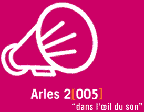
Sound is Art))): Call For Entries
"The Loud-speaker is probably the greatest common denominator in all our lives to-day. Video, multimedia, car radios, mobile phones are all crafting a new life for sound. In all domains sound is an objet of research, of reflexion. It is essential to open up creative, imaginative spaces for sound. And to encourage people to listen."-Christian Leblé
#01 Background: Among the prizes awarded for acoustic creation, the Phonurgia Nova competition has, since 1986, occupied a special place by virtue of its recognition of artists whose work exploits sound as a medium for expressing the real and the imaginary. The contest is open to all radio station formats and to all authors, independant radio producers, musicians, composers, sound artists. An international jury panel made up of representatives from the radio industry, the press and the sound art world judge the entries. In 2003, 150 productions from 19 different countries were entered in the prize.
#02 Call for Works
This year's competition will distinguish authors whose work manifests a keen sense of sound and listening as means of expression. The jury will deliberate on two areas:
A) Radio Arts will privilige all forms of inventive radiophonic creation: documentary, feature, fiction, essays, radio mix, Hörspiel, experimental forms etc.
B) New Media awards will go to sound installations or works which have been specially created for "new media" to bring new experiences in sound art to listeners - mobile phone, audioblog, website .
In each category the jury will deliberate on two types of work:
1)completed productions
2)projects
#03 How to apply
The competition is open to all artists without exception and for any work produced later than 2001, regardless of language, format, duration or genre. Each work or project submitted must be accompanied by a separate registration form, filled out in English or in French, and must be sent on a separate CD or other digital medium.
Each submission must include
-for finished products: a digital copy or transfer of the work (audio CD or DVD), accompanied by a well documented presentation of the work
-for projects: a description and/or maquette and/or a scenario of the project, accompanied by any documentation which could inform the jury as to the intention of and the technical facilities required for completion of the piece.
-a biography of the author(s) and general information concerning his (their) habitual manner of working (this will not be given to the jury).
-an authorization to participate from the production or the co-authors of the works submitted
-30 euros registration fee for each work submitted to the competition (there is a limit of two works per author).
One application form per project or production (and not one per author/producer)
An application form is available in PDF format from the link below
DOWNLOAD THE REGISTRATION FORM
#04 Prizes
The jury will award: one Radio Arts prize and one New Media prize each of 1 500 euros and three artist's residencies at GRM/INA, IMEB and GMVL, (three famous french sound art centers located in Paris, Bourges and Lyon). Ten works will be selected in each area for presentation at the third Festival de l'Ecoute, Arles, july 2006. Additional prizes could be given at this time.
#05 Deadlines
The closing date for registration of entries: September 1, 2005. Results will be announced on Saturday, October 1, 2005, in Paris at la Maison du Geste et de l'Image. The terms of artist-in residence will be organized during the year 2005-2006, in accordance with dates chosen by the prize winners. Prize winning works, or works produced during residencies, will be auditioned or exhibited at the Festival de l'écoute, Arles, 2006 and also by the associated production partners.
# 06 A listening room
From September 30th, an online "listening room" on www.transradio.org will enable visitors to have access to the selected works.
# 07 Sound archives
All the materials received at the Phonurgia Nova contest will constitue a permanent archive of audio works. This archive will be opened to the public.
# 08 Send Entry form and submissions must be received before September, 1st, at the address below :
Phonurgia Nova Awards
39, rue Genive
13200 Arles
France
All payment from outside France must be made by Internatinal Money order, by a cheque written on a bank located in France, or by direct bank to bank transfer to Association PHONURGIA NOVA, Bank : BNP Arles, 10 place de la République, 13200 Arles, IBAN FR76 3000 4000 4400 0201 4673 195 / BIC BNPAFR PPNIM. All bank charges must be prepaid. No refunds will be made.
# 09 Further information
For further information about this competition, please feel free to contact the Phonurgia Nova office in Arles :
tél. + 33 (0) 4 90 93 79 79
fax. + 33 (0) 4 90 93 86 23
email: info[at]phonurgia.org
Posted by jo at 07:22 AM | Comments (0)
April 28, 2005
Radio_Copernicus
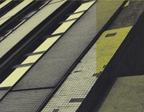
Call for Radio Art-Proposals
Radio_Copernicus is an independent and transnational experiment. Its topic is the artistic use of radio's electroacoustic spaces and materials as well as its diverse communication architectures and its metaphorical potential. Radio_C is dedicated to the multitude of aesthetic concepts and strategies of the digital age and will, at the same time, value the history of radio art and sonic media art in general. This will make Radio_C an art event in itself.
Radio_C will be on air from mid-July to the end of December 2005. The progam cooperates with media art and music festivals in Poland and Germany, such as "garage"/Stralsund, "Warsaw Autumn" and "Dis_Positionen"/Academy of Arts, Berlin. In early December 2005 the project will organize an international symposium dealing with the topic of independent artists' radio in Wroclaw/Poland.
Radio_C will be on air temporarily during the time of the festivals. Also, it will be constantly available as an Internet livestream for the international community. It will broadcast in Polish, German and English, and will cover a broad range of artistic categories, with spoken word based art forms and presentations being as important as experimental music, hoerspiel and sonic media art.
The project considers itself part of the recent movement of independent art und cultural radios, such as Resonance.fm, Reboot.fm, Soundscape.fm and many others. It relates to an idea of the Hamburg based sound artist Felix Kubin. Radio_C‘s aim is to strengthen the artists‘ access to radio, and seeks to join the political claim for independent artists‘ radio’s access to frequency and broadcast.
Productions and projects, which deal with radio's communication architecture, telematic media or want to connect radio with activities in public space are especially welcome.
Also submitted can be radio art pieces, earplays, sound art etc., which are already produced, up to a maximum length of 85 min.
Please, submit proposals for the first two transmission sets (July-September) until May 16 to:
Studio Radio_Copernicus
Universität der Künste
Lietzenburger Str. 45
D-10789 Berlin
Germany
Contact: Sabine Breitsameter info[at]radio-copernicus.org
Posted by jo at 07:56 AM | Comments (0)
April 20, 2005
Transmission
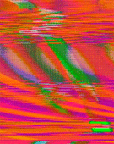
You Can Feel It in the Air
"At some point in our lives, we notice ourselves lugging around an overload of ideas and information. How is it that we continually play the role of unwitting receiver to a barrage of loaded transmissions? Transmission is a series of exhibitions presented by the New Museum of Contemporary Art, which profiles artists and scholars exploring the concept of 'transmission' in and through new media, radio, sound and broadcast media. 'Airborne,' the second show in the series, takes on the 'aesthetic, sonic and socio-political' aspects of these cunningly concealed wireless transmissions.
Curated by Anne Barlow and Defne Ayas, in collaboration with www.free103point9.com, the exhibition features seven works by New York-based artists that aim to give substance to intangible electronic signals and to the interests they power. Take Paul Davies 'Prayer Antenna,' which wittingly transforms viewers into supplicants as they kneel to insert their head into an ordained helmet covered with antennas; or Mendi and Keith Obadike's '4-1-9,' which invites one to compose an individualized email money transfer scam. Airborne will be at the New Museum until June 4, with performances on May 4 at 6:30PM." - Ophra Wolf, Net Art News, Rhizome, 04.20.05
Posted by jo at 09:31 AM | Comments (0)
March 16, 2005
Reinventing Radio: Enriching Broadcast with Social Software

Many-to-Many Radio
Reinventing Radio: Enriching Broadcast with Social Software byTom Coates, Matt Biddulph, Paul Hammond, and Matt Webb:
How could you enhance a one-to-many national radio station by building in the many-to-many-style interactions of Flickr or the weblog community? How might lessons from social software further blur the distinction between listeners and broadcasters by pushing interactivity beyond the phone-in or the online poll?
(1) The "Ten-Hour Takeover" used SMS technology, pattern matching, and statistical analysis to give the British public control of BBC Radio 1's musical output. For ten hours, there was no planned playlist--every track was chosen by listeners via text messages. We turned these messages into a navigable information space of artists, tracks, and listeners that the DJs could interact with directly. Moreover, the loosely coupled component-based infrastructure has allowed us to deploy new mobile-based products (SMS and MMS) quickly and easily.
(2) A component-based architecture also allows us to hook together SMS, track now-playing, and show scheduling systems with each other and with third-party services. BBC R&Mi are using this as a basis for exploring social software models of interactivity: the potential of Flickr/del.icio.us-style tagging for radio; the possibilities of combining buddy lists with media players; new applications for SMS; and concepts like "100 Composers"--DABJava applications on PDAs that can have data trickled to them over broadcast radio.
The session presents work from BBC Radio & Music Interactive's Technical Architecture and R&D teams, including demonstrations of existing software and working prototypes of new projects. Podcast. [from the O'Reilly Emerging Technology Conference] [Related]
Posted by jo at 11:23 AM | Comments (0)
March 08, 2005
dotdotdot
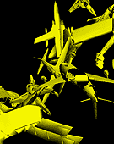
Glimpses of Unseen Places
A landscape from beyond the edges of the browser window that gives glimpses of unseen places. dotdotdot is constructed using several different motion capture systems and improvised performances creating abstract digital portraits. These animated avatars move and react to players inputs within an online virtual environment.
"dotdotdot provides a good example of the ways in which practitioners using old media and new media can collaborate to produce an ongoing body of work challenging the canons from which each component of the work orginates. Using motion capture, web tools, animation, games engines, sound and movement dotdotdot presents a series of animated interactive vignettes. These can be manipulated in terms of speed, sound, rotation and movement so that the basis of the range of visuals on offer stays the same but also so that the viewer/player can change them to accommodate their own preferences. [via Rhizome]
Each work has an Igloo signature but it allows the viewer to manipulate, play and be creative - after years of artists striving for truly interactive work, dotdotdot knowingly works with the limitations of interactivity in order to give the piece a characteristic style.
The viewer/player is presented with a range of choices involving genre orientated radio stations (you can choose drum & bass through to chart music) and a variety of visuals such as red, dot, bendy and plane. All these permutations and combinations together with the ability to interact with the animated figures in terms of speed and rotation challenge the viewer to think about the visual and audio styles in relation to their own experience of video, sound, animation and movement drawn from a variety of sources in day to day culture.
The project, which has been ongoing, is the product of Ruth Gibson, a dancer who is specifically looking at development of movement in the context of motion capture, and a programmer Bruno Martelli, who is interested in pushing the limits of technology in real physical contexts. The artists draw in expertise and collaborators as and when they need and the quality of the work is enhanced with every reworking. Their animations reflect these concerns with their 3D quality combined with recognisability of the human form in spite of the abstractness of the animated shape." Helen Sloan, Director - SCAN
Posted by jo at 07:38 AM | Comments (0)
March 04, 2005
New American Radio
![]()
Online Archive Continues to Grow
New Radio and Performing Arts, Inc. is pleased to announce that 16 additional full-length works have been added to the New American Radio web site, bringing the current total to 132. Sixty additional works will be archived in the coming months.
"Experimental sound art pieces commissioned by New American Radio, weekly radio program distributed to public radio stations from 1987-1998, became available online this past spring. At some point, New Radio and Performing Art, Inc., the organization responsible for this great resource, hopes to make over 300 works by artists such as Pauline Oliveros, Christian Marclay, and Terry Allen available through its site." From Stationary Flow: Process and Politics in Audio Art On the Air and Online by Claire Barliant.
"The expansion of the NAR website provides a good opportunity to examine reasons why radio has held such fascination as a medium for many artists, and how relocating to the Internet affects work designed specifically for radio. Part of the appeal of art made for radio is in the tension created when an experimental artist tries to subvert the medium's mainstream status while simultaneously leveraging its capacity to reach a wide audience.
Radio, like all "new" media, is charged with meaning, i.e., unlike canvas, it is not neutral material, nor does it easily shed its association with mass culture. When it first appeared, it was originally heralded as a tool to aid democracy. This vision quickly changed when a dramatic increase of radio sales in Germany in the early 1930s signaled an opportunity to the fascist regime for a new method of distributing propaganda. "With the careful administration of the daily programming the scene was set for authoritarian control," Bruce Barber wrote of radio's history in 1990. "The emancipatory potential of the new communications medium had been denied in favour of its limitless capacity to order information in such a manner as to ensure the unilateral demonstration of power."
The trick for artists is in learning how to embrace the medium's tics while downplaying the message. John Cage was one of the first artists to whom traditional radio programming appealed on a purely aural level. In 1956, he composed a piece titled Radio Music that included up to 8 radios playing simultaneously. It is interesting to note how deeply Cage, from the perspective of a composer, appreciated the radio. "There's one station now on the radio, in New York, that reminds me of Satie and that is WINS," he said in an interview in the early 80s. "It's a continuous news station, and the program, if you listen long enough as you are driving along the highway, more or less repeats itself in the same way that the Vexations of Satie would be repeated, because you come back to the weather at regular intervals and, in fact, to the same headline news." Anyone living in the New York area will be familiar with the importance of repeating elements to the identity of 1010 WINS as a radio station: there is the constant grumbling static running underneath everything, the insistent, falsely energetic force of the announcer's speech, the relentless iterations of the station's slogan ("give us 10 minutes and we will give you the world"), the weather and traffic details. Cage heard the potential for art in the sounds made by the station as well as those it couldn't control. The intermediary sounds of radio broadcasting famously also drew the attention of the Futurists, who demanded that La Radia should utilize "interference between stations."
Other artists have capitalized on radio's political possibilities. In the late 1960s, artist John Giorno created the "Radio Free Poetry" project, in which he set up guerilla radio stations at St. Mark's Church and the Jewish Museum in New York City. Activist sentiment fueled the operation. Giorno hoped to inspire others to do the same, and circumvent FCC regulations in order to broadcast alternative points of view as well as literature that was not easily embraced by mainstream media. Giorno's work foreshadows today's telecommunications systems, and prefigures a possibly Utopian view of the Internet as presenting an opportunity for anyone to become a cultural producer. Tetsuo Kogawa, the Japanese radio artist who pioneered the idea of "micro radio," transmitting radio within a limited area of signal, wrote that increasing FCC constraints preventing pirate radio are best circumvented through the Net; in fact, he believes that even "big" radio will soon be obsolete. "Sooner or later, large and global communication technologies will be integrated into the Internet," he writes. "Radio, television and telephone will become local nodes to it."
Putting the NAR archives online raises many questions that are impossible to answer now. The sounds of static and station interference may one day disappear with the advent of digital FM radio. Will a work of sound art that features these standard radio tics sustain its power as these sounds fade into ancient history? Listening to radio art online implies that interest in the process of radio recording is waning, and artists are turning to new technologies. As it continues to make its archives available, perhaps the New American Radio website will provide answers to these questions and others that pertain to radio art. It is interesting to reflect on the history of radio art, while sound art on the Net continues to turn up new complications that echo issues raised in the past, and still grapples with challenges raised by the Futurists long ago. Honor Harger is one artist actively exploring the complexity of sound art on the Net. Of r a d i o q u a l i a ' s use of Real Audio, in 1998 Harger wrote that, "We celebrate the hidden spaces where the alchemic transference of intent and error happens." Now that New American Radio has been put out to pasture, so to speak, emerging artists coming into contact with its constructions may be further inspired to stake out territory for sound art on the Net as the artists on NAR did with radio." Claire Barliant
Also read New American Radio and Radio Art by Jacki Apple.
Posted by jo at 03:47 PM | Comments (0)
February 25, 2005
SOUND ART MUSEUM
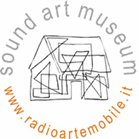
Radio Arte Mobile
Sound Art Museum, Rome, February 26th, 2005; broadcasting live on http://www.radioartemobile.it (Boston and N. Y. 12:30 p.m.; Bogota 1.30 p.m.; London 5.30 p.m.)
18:30: Larissa Harris at MIT Center for Advanced Visual Studies, Boston; François Bucher Bogota. Artists participating in the show Inaudita Roma, Ron Kuivila for Art in General New York.
19:00: Daniel Soutif at Centro per l'Arte Contemporanea Luigi Pecci Prato; Claire Staebler at Radio Day De Appel Amsterdam; Ian Aman, Joachim Granit e; Carsten Holler at Fargfabriken Stockholm; Richard Crow e Lucia Farinati at IOR London
Sound Art Museum is both an exhibition space dedicated to sound and vision, a collection of sound-projects by artists, and a mobile archive. The sound invades the scene of art and the artists' practice, triggering original, fascinating and, sometimes unforeseen, combinations. A new collective and international sensitiveness is seeking to gather and convey the reasons of these harmonies and these dissonances.
Radio Arte Mobile, located in via Conte Verde 15 in Rome, will open its doors to the public on occasion of the inaugural exhibition INAUDITA of the Sound Art Museum.
Installations by Acconci Studio, Markus Huemer, Donatella Landi, Stephen Vitiello and Achim Wollscheid, will be presented together with artworks of Mario Airo, Massimo Bartolini, Bruna Esposito, Vettor Pisani, Michelangelo Pistoletto, Annie Ratti, Gert Robijns.
It will be displayed a selection of sound art from the Archive of the Sound Art Museum, which has already filed more than 350 international and national audio works.
In collaboration with Nomads & Residents a series of appointments in institutional locations all over the world is scheduled, where the archived materials will be available for public use.
The curators of the Sound Art Museum are Lorenzo Benedetti freelance curator, Riccardo Giagni composer and musicologist, and Cesare Pietroiusti visual artist.
The Sound Art Museum archive is a work in progress, all artists who have worked or are working with sound are always invited to send the an artwork on audio CD DVD or on a vinyl record.
Posted by jo at 06:10 PM | Comments (0)
February 07, 2005
RADIO TAXI

Going Glocal
RADIO TAXI is a Taxi Gallery narrowcast and webcast initiative. Taxi Gallery is literally a black cab situated in a council estate on the outskirts of Cambridge, England. Since Sept 2001, over 25 different artists have made new works in response to the specific context offered by the gallery and its location. Taxi Gallery is a project that reaches for an extended conversation with local, national and international audiences (via its website) in response to a broad range of challenging contemporary artworks, approaches and ideas.
The translocal or "glocal" philosophy of Taxi Gallery is reflected in the forthcoming RADIO TAXI project which will integrate a 3 mile radius analogue FM broadcast with a worldwide digital transmission via a server capable of handling multiple streams. RADIO TAXI will be a live(ly) mix of locally originated programmes and interventions (significant community involvement by neighbourhood residents of all ages will be developed, including several major projects with Coleridge Secondary School and an evolving radio club), a curated programme of invited sound works and a schedule of sonic art from all over the world.
Kirsten Lavers, cris cheek, (TNWK) and Simon Keep invite sound artists (including writers, poets, visual artists, musicians working with sound) to submit work for a short range FM and internet radio event in late May and early June 2005.
Submission Deadline: 1 May 2005-01-22 latest
Transmission Dates: 6pm 27 May – 6am 31 May (GMT) & 6pm 3 June – Midnight 5 June (selected highlights)
Queries to: info @ radiotaxi.org.uk
Posted by jo at 09:54 AM | Comments (0)
February 03, 2005
free103point9

Transmission Arts
free103point9 is a 501(c)(3) nonprofit media arts organization focused on establishing and cultivating the genre Transmission Arts by promoting artists who explore ideas around transmission as a medium for creative expression. These investigations include practices in AM and FM radio, Citizen's Band, walkie-talkie, generative sound, and other broad and microcasting technologies utilizing the transmission spectrum. free103point9 serves diverse public audiences through programs including an online radio station, a distribution label, a performance/exhibition/ transmission series, a preservation program, an education initiative, and a forthcoming artist-in-residency program.
Founded in 1997 as a microcasting artist collective, free103point9's goals during the formative years were focused on the microradio movement fight for the public's access to its own airwaves. free103's mobile operations made airtime available to community voices, local bands, and most significantly to a group of under-served artists shaping conceptual works specifically for radio transmission.
Posted by jo at 05:58 PM | Comments (0)
January 26, 2005
Microwave Boombox

Tools for radio waves hunters
Third part of part of Strangely Familiar. Unusual Objects for Everyday Life. Oren Horev, Myriel Milicevic (who had worked also on the Zone project) and Marcos Weskamp designed the Amazing All-Band Radio, three innocent-looking devices that allow users to hunt short, medium and long radio waves from the comfort of their home.
The antenna of the Microwave Boombox captures the high-frequency signals of wireless communication devices and translates them into sound. Radio Radio tunes into different wavelengths physically, by extending the string-antenna. The longer the string the higher the wave frequency. Cosmic Radio looks for long waves signals that reach us from the stars and the depths of the earth (above left). [blogged by Regine on we-make-money-not]
Posted by jo at 10:22 AM | Comments (0)
January 20, 2005
Tele-tap

Transparent Borders
"Where are the borders between public and private? Between art and life? Between urbanity and individual? - The project Tele-tap by the Amsterdam women artist group CUT-n-PASTE connected its listeners with a number of personalities active in Amsterdam's nightlife: a member of the Salvation Army, a harbour worker, a musician, a woman strolling through the pubs. Each of these personalities went into his urban environment, in his auditory-communicative hunting ground, lived there his life, played his role, provoked encounters. This was transmitted live by the permanent open mike of their mobile phones. Each of them could be wiretapped by the audience via radio, Internet or at the performance venue. Tele-tap showed how undefinable the borders can become between intimate and public space in a mobile communicating society. The technical »heart« of the project is the Internet, where the mobile phone sound inputs were converted into live audio streams and were audible all over the world. These streams also went on air as radio signals, and were accessible by headphones and loudspeakers at the performance venue itsself. The last time Tele-tap was live aired and live performed was on August 31 and September 1, 2001 on the Dutch radio channel VPRO and at »De Balie«, an Amsterdam cultural center. New technologically and dramaturgically extended versions of the project are in preparation. [via AudioHyperspace]
Posted by jo at 03:19 PM | Comments (0)
the Electronic Guy
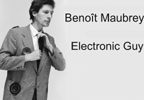
Performing Electro-Acoustic Clothes
Benoit Maubrey performs the Electronic Guy (guitar, sampler, electroacoustic Jacket, solar radio); Video In Studios, Vancouver February 14th, 8:00 PM; and Location 1, NYC, February 18th, 8:00 PM. Following the performance will be a video and slide presentation concerning Die Audio Gruppe.
Benoît Maubrey is the director of Die Audio Gruppe, a Berlin-based art group that builds electro-acoustic clothes and performs in them. Equipped with movement and light sensors, radio receivers, sound generators, samplers, amplifiers, loudspeakers - the clothes produce sounds by interacting with the environment and in response to the performers' movements (past examples: AUDIO BALLERINAS, AUDIO GEISHAS, AUDIO STEELWORKERS, BONG BOYS, AUDIO PEACOCKS...).
Stay tuned for Phonomaniacs (see web site): Maubrey's visit is the opening movement in a larger cooperative project between Die Audio Gruppe and local artists being planned for later this year. It will consist of a series of workshops followed by a sound event featuring 20-30 electro-acoustically costumed performers.
Posted by jo at 09:56 AM | Comments (0)
January 14, 2005
Permanent Creation
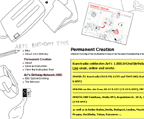
Art's Birthday 2005
This year's Art's Birthday celebrations in Vienna stand under the motto Permanent Creation and will - as in previous years - take place as a networked project with partner nodes around the world joining in and contributing to the broadcast special. For the first time, also the Ars Acustica group of the European Broadcasting Union (EBU) will participate in the Art's Birthday special and send acoustic contributions and sound samples serving also as source material for new pieces via satellite, thus expanding the global network by national broadcasting companies in Baden - Baden, Berlin, Madrid, Moscow, Oslo, Prag, Stockholm and Vienna.
In Vienna, the artist groups alien productions and IFTAF - Institute for Transacoustic Research will perform and jam with the partners of the network and will stage miniature performances due to instructions either submitted by the audience or from a collection of action instructions. For these performances, there will be a range of props available in the studio and each of the short acoustic actions will be performed within a fixed setting: a white table equipped with various (analogue) tools.
You can add your instruction for Permanent Creation to an on-line pool, which is the base material for the miniature performances. Furthermore, listeners of Kunstradio as well as artist collegues are invited to come to the studio and join in the action.
on air: OE1 Kunstradio (FM, SW, MW) - 21:00 - 23:00 GMT
on line: http://kunstradio.at
on site: Funkhaus, Studio 3, Argentinierstr. 30a, A - 1040 Vienna
The History of Art's Birthday
WIENCOUVER 2000
"In 1980, when the modern Fax machine was still an exotic promise and computers either massive mainframes or playthings for the hobbyist, artists in Vancouver and Vienna were collaborating on the first of the projects known as Wiencouver. WIENCOUVER 2000 is not a nostalgic look at the early years of Art+Telcomm but an exploration of the new technology available for artists working in the field as we approach the new millenium."
"Art's Birthday Party is a celebration in memory of Robert Filliou who declared, on January 17, 1963 that Art had been born exactly 1,000,000 years ago when someone dropped a dry sponge into a pail of water. 10 years later he celebrated Art's 1,000,010th birthday in the Neue Galerie, Aachen.
After Filliou's death in 1987 some artists began to celebrate Art's Birthday with mail-art, fax and slow scan tv events in the spirit of his concept of "The Eternal Network" or "La Fete permanente." The Birthday parties took place in different cities across the world and artists were asked to bring birthday presents for Art. -- works that could be shared over the network.
Art's Birthday Party has never been a formal event but was always organised on an ad hoc basis through the network. Every participating location (and they are different every year) organises its own party - from a few friends in a private studio to a performance evening in a museum, gallery or radio station . The only condition is that each group is able to send and receive birthday presents for Art. Since 1994 this has usually meant using the Internet in one form or other.
Filliou's invention of Art's Birthday is wonderfully absurd and humorous in the typical Fluxus tradition of serious fun. So the global birthday party for art has always tried to be fun while paying homage to Robert Filliou's dream of The Eternal Network." Robert Adrian 2004
Art's Birthday Network
EBU Ars Acustica Special Evening
Posted by jo at 12:26 PM | Comments (0)
January 03, 2005
MuSE

Multiple Streaming Engine
MuSE provides the free software community with a user friendly but powerful tool for network audio streaming, making life easier for indypendent free speech online radios.
MuSE is an application for the mixing, encoding, and network streaming of sound: it can mix up to 6 encoded audio bitstreams (from files or network, mp3 or ogg) plus a souncard input signal, the resulting stream can be played locally on the sound card and/or encoded at different bitrates, recorded to harddisk and/or streamed to the net. When sent to a server, the resulting audio can be listened thru the net by a vast number of players available on different operating systems.
To be operated MuSE offers graphical interfaces and a documented commandline interface in the good old unix style. MuSE is free software and it is released open source under the terms of the GNU General Public License.
Posted by jo at 08:07 AM | Comments (0)
December 27, 2004
netzwissenschaft
![]()
Emerging Infrastructures of All (Inter)net Research
Dr. Reinhold Grether's network research | netzwissenschaft site maps the "emerging infrastructures of all (inter)net research endeavours. net.science as an anthropology of connectivity is trying to overcome the constraints of specialist method transfers on net matters. the protuberance of technical networks necessitates a professionalization of human net knowledge. neither the isolation of concepts as in basic research nor the encapsulation of processes as in applied sciences will ever be able to adequately describe the complex autopoiesis of networks. net.science is undoubtedly developing into a scienza nuova of its own right."
Check out his Mobile Art and Virtual Performance research areas.
Posted by jo at 04:45 PM | Comments (0)
December 02, 2004
.ran [real audio netliterature]
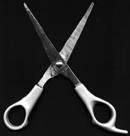
Automatically Generated Authorship
In five parts, the series .ran [real audio netliterature] - curated by Johannes Auer - will pick up various approaches of net literature (code, montage/collage, authorship, text-image-(sound) indifference, reference systems) and try to apply them to the medium radio. The current panorama is sketched out approximately by presenting 5 different positions.
December 5, 2004, 23:05-23:45, KUNSTRADIO: .ran part 2: "Authorship and its automatic generating" by Cornelia Sollfrank and Timothy Didymus: along with the possibility of technical reproduction provided by the printing machine the individualization of authorship came in the 18th century, as well as the invention of copyright. During the 20th century, a diversity of artistic attemps was undertaken in order to deconstruct individual authorship and the implied ideas about geniality and originality.
Started by Dada and continued by the Surrealists one can follow this development which now faces an expected culmination, caused by the rise of the digital media. Playing with identities, the availability of an endless amout of material and information on the Net, the possibility of copying without loss of quality, as well as anonymous and decentralized ways of distribution have formed a networked culture which often makes it impossible to identify a single author. And also the works are in a permanent state of re-work and variation.
"Generative art" is a special variation of this networked culture. Here, authorship very often is distributed to several contributors - for example the user, the programer, the artist who makes the concept and provides the environment, the authors of the re-worked 'original' material, and most import the computer(-program). A consequent handling of this kind of art, makes it hard to almost impossible to categorize it by parameters like "authorship" and "originality" on which not only the art world but also copyright is based.
The radio play "Automatically Generated Authorship" tries to relate in form and content to the described development. Four characters represent the different layers of discourse around the issue: a male and a female computer voice, as well as a male and a female human voice. The spoken text, noise and generative music compositions comprising the radio play have been rendered from a jump-cutting timeline. Although the content is seeded by the authors (Sollfrank & Didymus), the final form has been left purely to a software based music-engine to arrange.
The shock of jump-cutting, the un-fixing of order, creates new symbiotic meanings and relationships, manifesting not only as a disruption of the codes of listening, but also perhaps more importantly a 'bringing together' of ideas not (fully) intended by the artists. This act demonstrates the seductiveness of the timeline, and time based media in general.
next programme:
23.1.05 Sylvia Egger: DADA TO GO: A WALKTHROUGH LEVELS
30.1.05 Heiko Idensen: live!
13.2.05 Florian Cramer: Codeworks
previous programme:
07.11.04 Beat Suter/René Bauer: Man - Machine :: Apple in Space ::
Search the World
Posted by jo at 11:57 AM | Comments (0)
October 18, 2004
AudioHyperspace

audio »visions«
The Internet offers to the media as well as to the media artist a new electroacoustic space, abundant with audible live streams, audio on-demand, sound files and increasingly complex interactive audio art. These new possibilities may open up surprisingly new audio »visions« and provoke new strategies of perception. Audio on the Internet has made the boundaries between art, communication and play flexible. This offers a perspective on radio concepts and on radio art designs. AudioHyperspace guides you through the jungle of sound data and explores the development of sonic web art: every month it selects the most interesting audio websites and presents an annotated collection of links to audio and audio art on the web. Some examples of interviews:
Mobile Listening - Electrical Walks
Christina Kubisch in Conversation with Sabine Breitsameter
Sonic Art in Hertzian Space
Teri Rueb in Conversation with Sabine Breitsameter
Birdsong for the Mobile Age
Sadie Plant in Conversation with Sabine Breitsameter
Posted by jo at 12:56 PM
September 22, 2004
Performing in Space
You can listen to the planet Jupitor and its interaction with its moons; hear radiation from the sun, the sound of activity from far-off pulsars or other astronomical phenomena.
radio astronomy is an art and science project which broadcasts sounds intercepted from space live on the internet and on the airwaves. The project is a collaboration between r a d i o q u a l i a, and radio telescopes located throughout the world. Together they create 'radio astronomy' in the literal sense - a radio station devoted to broadcasting audio from our cosmos.
Radio Astronomy has three parts: - a sound installation - a live on-air radio transmission - a live online radio broadcast - The content of the live transmission depends on the objects being observed at the time by partner telescopes . But whatever they may be, listening in guarantees you'll no longer think of space as silent but rather as a rich acoustic environment prompting comparisons with avant-garde music and electronic sound art.
Posted by newradio at 02:20 PM | Comments (0)
September 18, 2004
Automated Prayer Machine

Immersive Radio
The Automated Prayer Machine repositions radio as an antidote to despair. We create an expansive radiophonic sound environment by manipulating signals rebroadcast through a low-watt FM transmitter to multiple receivers in the audience. Digital video projection, live accordion, violin and voice complete the circuit, activating the metaphorical prayer machine.
"Bridging locative media and radio, as well as offering a critical and feminist voice, is the work of Anna Friz...and Annabelle Chvostek...Automated Prayer Machine...seeks to "proactively change the function of radio" by integrating radio speakers into (what was) the audience, thereby "activating acoustic listening space that also has a radio quality... making one aware of being out in the audience, in an immersive radio experience."
Mixing live radio samples, shortwave noise, fundamentalist talk radio, and prayers sent via voicemail and email, Chvostek and Friz are reinserting community voices and empowering wireless practice and discourse by spanning the tradition of radio with an awareness of context and location that addresses the crucial tensions of the wireless arts. For Friz, "radio addresses the same subjects new media tried to address. The hopes are and were the same, the barriers are the same: Who are you when you are in this mediated state? What is it that you want? How profound is this communication, and through the distance and nearness of geography? In new media, the tool still leads the work: beware the tool that leads." From "Sound Tracks and Data Footprints Stalking the footfalls and echoes of the wireless invisible," Tobias C. van Veen, HorizonZero, Issue 15.
Posted by jo at 08:39 AM | Comments (0)
August 29, 2004
tune in
www.free103point9.org
Sunday 08.29.04- Thursday 09.02.04
LIVE AROUND THE CLOCK COVERAGE OF THE PROTESTS
SURROUNDING THE REPUBLICAN NATIONAL CONVENTION
free103point9 Online Radio is partnering with
the August Sound Coalition to provide coverage of
events during the convention.
Tune in at www.free103point9.org
Posted by newradio at 11:48 AM | Comments (0)
August 21, 2004
ultra modern - very social
Another Motherboard project, ultra modern - very social is a streaming theatre concept for 2002 and beyond. This space is dedicated to the pursuit of experimental theatre which is somehow modulated and mediated by the intermediary influences of the net, but may also involve communcation appliances such as telephones, mobile phones, walkie-talkies, radio, etc. Our emphasis is on improvisation and experimentation where "here and now" and "there and then" are relative expressions in collaborative networked spaces.
Posted by jo at 11:31 AM | Comments (0)
August 20, 2004
where are we eating?
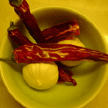
Digesting Sound
where are we eating? is a translocal radio feast. Site-specific dining at ISEA 2004 and around the world. This is a project which aims to nourish. "We are interested in exploring hybrid transmission spaces dispersed and mobile modes of exchange, eating as a particpatory performance, cooking as a collaborative creation."
where are we eating? radio feast will be broadcast on 21-22 August 2004 on ÄÄNIRADIO 103.1 FM, online and on the streets of Helsinki where Grilli Radio will explore the local foodscape.
Posted by jo at 11:52 AM | Comments (1)
August 19, 2004
Active Ingredient
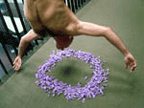
New Moon Radio
Active Ingredient have been creating exciting and innovative projects since 1996. Their work has included: Chemical Garden, “A modular garden built in units containing strange plant life and internet controlled robots”; Ghost Engine, a live online séance; Big Up Yourself, a participatory project working with Galleries of Justice.
Moon Radio, begun in 2000, has hosted many live broadcasts, new films and commissioned projects. All New Moon Radio... marks a new era for the project, reflecting the changing pattern of innovation on the web. Now at the heart of the project is the audience - their web community – interactivity and participation. Using chat rooms, SMS texting, community profiles (…and coming soon artist Blogs) Moon Radio aims to become a space that is alive with debate, activity and new projects, reflecting the audiences needs and desires.
Posted by jo at 11:42 AM | Comments (0)
August 18, 2004
neuroTransmitter [nT]
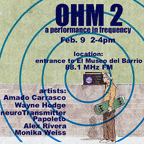
Through the Membrane
Founded in 2001, nT is a radio collaborative utilizing analog communication technologies. Working specifically with radio machinations, neuroTransmitter propels signals through urban membranes and cellular formations. To complement their fixed and mobile frequency performances, nT creates radio-sonic installations, produces music, and converts utilitarian objects into radio transmission and receiving devices. Projects include:
PUBLIC_RADIO connects the newspaper dispenser with the airwaves altering public expectation and engagement with the dispensing object. From July 20-21, 2002 as part of the Dispensing with Formalities series, a live radio transmission was performed and broadcasted in the vicinity of public_radio.
com_muni_port--is a portable radio broadcast unit--consists of an FM transmitter, CD player, microphone, headphones and multi-channel mixer, all powered by a battery pack. Its portability renders its use within political rallies and marches, by mapping audio frequency within a city, and spontaneous interviewing and broadcasting. com_muni_port has myriad communicatory and interventionary functions, all in one unit.
Posted by jo at 05:44 PM | Comments (0)
August 17, 2004
Autonomous Radiobodies
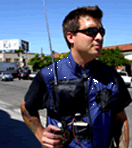
radiophonic graffiti
Autonomous Radiobodies is a public art performance/installation that involves people wearing or carrying units equipped with a Radio Graffiti Device for creating localized radiophonic art/graffiti spaces. As the technology of traditional radio hangs on the edge of artistic obsolescence and state-financed broadcasters use the medium to construct and enforce a national voice, newer mobile technologies are springing up and grabbing the public attention for commercial communication and artistic expression. This technological hype for the new presents an opportunity to exploit and reinvestigate the older wireless medium of radio and it’s renewed use as an art-space. Read more>>
Posted by jo at 02:45 PM | Comments (0)
August 09, 2004
Kunstradio //\ art@radio
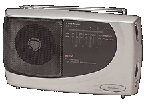
jamming radiophonic space
art@radio is pleased to present "jamming radiophonic space," an international on air- on line- on site event September 3rd from the studios of the University of Maryland, Baltimore County in participation with the project RE-INVENTING RADIO a Co-production of Ars Electronica Festival and Ö1 Kunstradio. "We are interested having artists phone in environmental sounds via cell phone during the event. These sounds should deal with notions of connectivity and the current environment in which call originates. If you are interested in contributing to the cell phone part of the event please e-mail projects@joereinsel.org."
"jamming radiophonic space," modulates the interplay of radio, Internet, wireless transmission, and mobile phone signals from public and private space. Live stream: 13:30-00:00 Baltimore, Maryland [GMT "time converted"]
Artists: Goeff Bell, Steve Bradley, Phaye Poliakoff-Chen, Chad Eby, John Hopkins, Brendan Howell, John Hudak, Jacob Kirkegaard, Tim Nohe, Joe Reinsel, Jodi Rose, Bill Shewbridge, Nicole Shiflet, and John Sturgeon
This experientially diverse and geographically scattered group will contribute to "jamming radiophonic space" through decentralized, networked and collaborative strategies of production and distribution. Streaming feeds from microphones placed in and around artists' workspaces will be gathered along with ambient sound called in via wireless and landline phones; requests have already gone out over electronic list-serves for individuals to call in and point their live phones for 10 or 15 minutes toward sounds emblematic of their time and place.
These sonic interruptions will then be mixed and processed into a stream of "hot media" by artists present in the Baltimore studio space using baby monitors, short-wave radios, software and other improvised sound tools. The stream will then be made available worldwide to streaming clients via wired and wireless data connections.
For more information and a detailed schedule refer to http://art-radio.net/kunstradio/
Posted by jo at 12:16 PM | Comments (0)
August 05, 2004
Radio Cycle

Sound Interference
Radio Cycle, produced by Kaffe Matthews and collaborators, is a live radio station that broadcasts your stories, news and favourite sounds directly onto the streets as teams of radio-carrying cyclists map out the East end. It was part of Interference: Public Sound which took place in the UK in 2003. The project brought together a series of sound art projects "that engage with communication and shared memory as well as reflecting the current crossover of art, technology and action."
"Growing out of a week of workshops in Bow, Radio Cycle's highlight was a series of pieces that were broadcast and ‘played’ by a group of cyclists carrying radios and following predetermined routes in the area. Citizens out and about in London Fields, Victoria Park and streets in the vicinity would encounter these mobile soundworks as they drifted by on wheels. The local streetmaps, Matthews explains, took on the character of scores for her.
"It suddenly dawned on me that the radio itself is like a mobile stage," she tells me. "Originally I wanted to have a mobile radio station but we couldn't do that because you're not allowed to have a licence and be mobile. Radio Cycle was about this invisible activity, this subtle alteration of what's going on around you. Which explains the bicycles. You'd be walking down the street and a bicycle goes by. You probably wouldn't notice the bicycle but you'd notice some sound. A piece of music floating by. Just subtle little tweaks, altering people's environment to turn them on to what they're hearing." Continue reading at Wire feature by Will Montgomery, September 2003.
Posted by jo at 05:00 PM | Comments (0)
July 31, 2004
Mobile Culture-Scratching
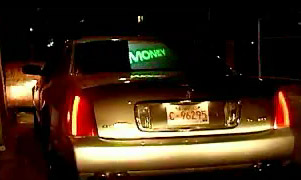
by Julie Andreyev, at New Forms Festival 2003, consists of 3 cars fitted with video projection on the rear windshield. Each car has a theme determined by the character of the car, and by characteristics of the host city where the fleet is mobilized. The choice of cars for the project reflects the specific car culture of the host city expressed through customization and branding.
Mobile Equipment
The cars are set up with equipment to allow for mobile video downloading, and video mixing using data from the car. While the fleet is mobile, videographers in the downtown site are creating videos for projection on the cars. The themes are used as a guide for them to create footage of the activities of a city's inhabitants.
Networked Process
This footage is uploaded by the videographers onto a web server. Then, the footage is downloaded by the cars as they drive by WIFI (wireless internet) download sites. A sound artist records ambient sound using a microphone held outside the window of one of the cars, mixes this, and plays it back using an FM transmitter. Nearby cars can tune into our frequency and hear the audio sampling. Each car is equipped with a sensor and software patch that interprets data from the car.
Software Interface
For example, one sensor reads data from the engine speed. This data causes a kind of 'jittery' effect to be applied to the video. The faster the car revs, the more 'jittery' the video. In this way, not only are the inhabitants of the city portrayed, but also the car is expressed in the video. After the performance, the cars can be driven into a gallery space where they can be set up to project their archive of the evenings' videos.
Mobile Portrait of the City
The goal of this project is to create a mobile portrait of the city through video and audio sampling of real time events. VJ-Fleet relies on current VJ (or video jockey) culture and the hosting city's local car and social culture. For each performance the project is customized and scaled to reflect the particular nature of the host city.
Posted by michelle at 06:37 PM
July 27, 2004
Networked Streaming Audio Performance
forwarded by Shu Lea Cheang -
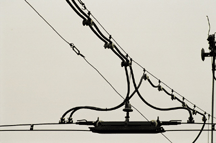
TRAMJAM - VIENNA RUSHHOUR by Mumbai Streaming Attack
A multi-track-multi-driver mix hub streaming jam session of Vienna city vibe, orchestrated in sync with the city's tram routing schedule.
TRAMJAM is a project that Shu Lea Cheang started when teaching networked performance at Zurich's HGKZ. The work will go on to other cities where there are tramlines. The next stop- Rotterdam and the Deaf Festival ’04 Affective Turbulence: The Art of Open Systems in November.
Thanks for sharing this event Shu Lea.
Would you comment on your involvement in this project?
Can you, for instance, compare the Zurich and Vienna experiences?
Is there online documentation of the Zurich events that you can direct folks to?
Collaborative and collective process is really important to us (blog & conference organizers) and we see it as a core component of networked_performance - both within groups developing work, and with the inclusion and contribution of viewers/users/participants/ to the work. The website notes that 'the Mumbai Streaming Attack study group expands to include local participants for each performance'. Do you mean in the respect that participants can upload sounds and contribute in that manner - or do you also connect with local artists for implementation/augmentation of prior iterations of the work? Would you talk about the technology and process involved?
Would you give us an overview of your personal practice and describe how this particular project is a continuation of that or has grown out of your former practice? Would you comment on your specific involvement in this project?
ABOUT THE WORK: Each driver/jammer conceives and collects soundfiles for a chosen tram route, joins together on location and online to perform collective impressions of Vienna city limits, whose tramlines connectivity forms the city's transport mainframe.
Along each tram route, personal, social and political association are considered for the composition of the specific sound files. Local sound artists, hackers, jammers are invited to “drive” and “mix” the (sound)stracks. The city's tram info broadcast cuts in to inform the happenings by the minute as the trams cable through the cities.
TRAMJAM also extends its programming to involve the city's mobile community. Through mobile devices, the transporting public are invited to send in voice/sound/texts messages for the mix.
The live performance is streamed live on the internet and on local radio. We invite the travelling public to listen in with their travelling radios. The orchestration of the tramlines/tramtracks is self-directed syncopation with open source soundfiles that are accessible to all participants.
Mumbai Streaming Attack is a networked performance study group currently based at SNM/HGKZ in Zurich. The group first performed TRAMJAM-ZURICH RUSHHOUR for broadcast at reboot.fm (Berlin) in February, 2004. The group's members expand to include local participants for each tram city performance.
Posted by michelle at 01:58 PM | Comments (2)
